A publication of

BONEFISH & TARPON
Journal
INSIDE: FLORIDA KEYS SANCTUARY PLAN • BAHAMAS HURRICANE RECOVERY • CUBAN COLLABORATION CONSERVATION THROUGH SCIENCE • SPRING 2020
Oh ! The Places They Take You ...

Partners In Preserving The Fish And The Places They Roam.


14 Florida Keys Sanctuary Blueprint
BTT responds to the Florida Keys National Marine Sanctuary’s proposed management plan.
18 BTT Education Program
The innovative new education program launches in Florida.
20 Solving The Bonefish Puzzle
Scientists seek elusive bonefish spawning sites in the Florida Keys using acoustic telemetry.

24 Bahamas Hurricane Recovery
After the worst natural disaster in the nation’s history, the Bahamian fishing community bands together to rebuild.
30 Bonefish Contaminants: The Invisible Threat
Troubling preliminary data show bonefish are exposed to an array of pharmaceuticals.
38 Two Nations, One Fishery
BTT works with Cuban collaborators to conserve the shared flats fishery.
Features

Updates/Reports: Setting the Hook ............................................ 4 Perspectives ................................................... 6 Welcome Aboard ............................................ 8 Tippets .......................................................... 10 Conservation Captain Q & A ......................... 36 2020 Artist of the Year: John Kobald ............ 42 Bonefish & Tarpon Trust Events .................... 46 2019 Donor Roll ........................................... 50
Photo: Marty Dashiell
Setting the Hook
From the Chairman and the President

November’s full moon marked the beginning of the bonefish spawning season. It was also a stretch of days that we had circled on our calendars months before, anticipating another adventure in nature.
After landing on the old air strip at Sandy Point, Abaco, we hitched a ride to the dock with a local pastor, who shared stories of resiliency and recovery in the aftermath of Hurricane Dorian. He was curious to know more about what had brought us to this part of the island, which hadn’t seen many travelers since the storm. He listened intently, understanding the importance of the fishery, and his young son was rewarded with a BTT “Bahamas Strong” cap for sharing the ride with us.
Our adventure unfolded over the next three days with BTT’s scientists and collaborators as they tracked spawning bonefish and studied the complexities of their reproductive biology. Our companions, fellow “citizen scientists,” were Raymond Floyd, PGA Hall of Fame golfer turned passionate flats angler, and BTT board member Carl Navarre and wife Pam.
On cue, the autumn moon began luring bonefish off the flats across a vast area in Abaco to a single location near deep water and, just like last year, precisely three days in advance of the full moon. But

 Harold Brewer, Chairman Jim McDuffie, President
Harold Brewer, Chairman Jim McDuffie, President

as cyclical as nature may be, it can also be unpredictable. Sharks molesting the aggregation kept pushing the fish back to the beach. They didn’t move offshore that night or the next two but waited until their numbers grew enough to withstand attacks by predators, finally slipping off the ledge and into deeper water three nights after first staging.
Based on the M/Y Albula, a 200-foot research vessel generously donated to us by the Fisheries Research Foundation, and with other boats and drones deployed to support the effort, the BTT team has been able to document valuable new information about bonefish spawning. Some of it is remarkable, even unimaginable, before the project began, from the distance these fish travel to reach an aggregation site to the previously undocumented depths this otherwise shallow-water species descends during a spawn. We look forward to sharing more about these discoveries with you in the near future.
The process of discovery is important to BTT. The more our research programs have developed over recent years, the more we have learned—all to the benefit of flats conservation. In this issue, you can read about the discovery of harmful pharmaceuticals found in bonefish and how BTT’s collaborating scientists from Florida International University and other institutions are working to determine the extent and severity of the contamination risk. This information will help us to formulate an effective response. You can also read about the search for long-elusive bonefish spawning sites in the Florida Keys. Unlike in the Bahamas, where several sites have been identified over recent years, the search is requiring a more concerted effort in Florida. Finding these sites is the critical first step toward conserving them.
Looking back on our adventure in November and on BTT’s development as a science-based conservation organization, we are reminded again of the important role our founders played. We honored two of them in January, when Stu Apte and the late Billy Pate were inducted into BTT’s Circle of Honor. We are grateful for all they did to help build and shape BTT—efforts that have contributed to the impressive work we’re proud to share in these pages.
BTT board member Carl Navarre, his wife Pam, BTT President and CEO Jim McDuffie, BTT Director of Science and Conservation Dr. Aaron Adams, PGA Hall of Fame golfer Raymond Floyd, and BTT Chairman of the Board Harold Brewer.

Perspectives
7th International Science Symposium
Bonefish & Tarpon Trust held its first science symposium nearly 20 years ago, when a small group of scientists, resource managers, and flats anglers gathered to exchange information valuable to their shared conservation objectives. Those early exchanges helped frame new research projects as well as shape future conservation approaches—and they planted a seed for what would become a one-of-a-kind event mixing science, fishing, conservation, and education.
Now, two decades later, this triennial gathering has grown to 1,000 participants and will return on November 13-14, 2020, at the Bonaventure Resort & Spa in Weston, Florida.
“The 7th International Science Symposium and Saltwater Flats Expo, presented by BTT platinum sponsor Costa Del Mar, promises to be the biggest and best yet,” said BTT President and CEO Jim McDuffie. “Internationally recognized marine scientists will share their latest research with a wide range of stakeholders, from resource managers and educators to fishing guides and anglers. We’ll also have many opportunities to celebrate our shared passion for the flats fishery through special panels, presentations, and social activities.”
The theme for this Symposium will be Conservation Connections Conservation Connections occur in many ways: research documenting the connections among bonefish, tarpon, and permit populations around the Caribbean, Gulf of Mexico, and southeastern US; education as a tool to share scientific findings with guides, anglers, and resource managers; scientific findings being applied directly to conservation and management; connecting scientists with guides and anglers through research partnerships; information sharing among scientists, guides, anglers, and resource managers.
In the three years since the last Symposium, a number of significant discoveries have been made while other research projects continue to unfold, revealing new aspects of conservation connections.
“Our Science Sessions are lining up to be even more eye-opening than at the last Symposium in 2017,” said Dr. Aaron Adams, BTT’s Director of Science and Conservation. “There is some groundbreaking research occurring as you read this, and results will be ready to be revealed in time for the Symposium. Most important, the Science Sessions will focus


on how the science is being applied to conservation, which means healthy fisheries for the future. And new for this Symposium will be regional conservation discussions.”
Attendees will enjoy educational and inspiring Expert Panel discussions on flats fishing and destination travel, casting demonstrations, an introduction to BTT’s new Education Program, the always entertaining Film Night, and the Saltwater Flats Expo, featuring the latest fishing tackle, gear, and skiffs from many of the sport’s leading companies.
Visit BTT.org/Symposium for the latest updates and to reserve your spot—the last Symposium sold out.
 Key West, Florida. Photo: Ian Wilson
The 2017 BTT International Science Symposium’s Tarpon Legends Panel (left to right): BTT founding member Stu Apte, BTT board member Capt. Paul Dixon, Capt. Tommy Locke, Capt. Paul Tejera, BTT Vice Chairman Bill Horn, BTT board member Julian Robertson III, Capt. Bouncer Smith, Andy Mill, and BTT collaborating scientist Lucas Griffin. Photo: Pat Ford
Key West, Florida. Photo: Ian Wilson
The 2017 BTT International Science Symposium’s Tarpon Legends Panel (left to right): BTT founding member Stu Apte, BTT board member Capt. Paul Dixon, Capt. Tommy Locke, Capt. Paul Tejera, BTT Vice Chairman Bill Horn, BTT board member Julian Robertson III, Capt. Bouncer Smith, Andy Mill, and BTT collaborating scientist Lucas Griffin. Photo: Pat Ford
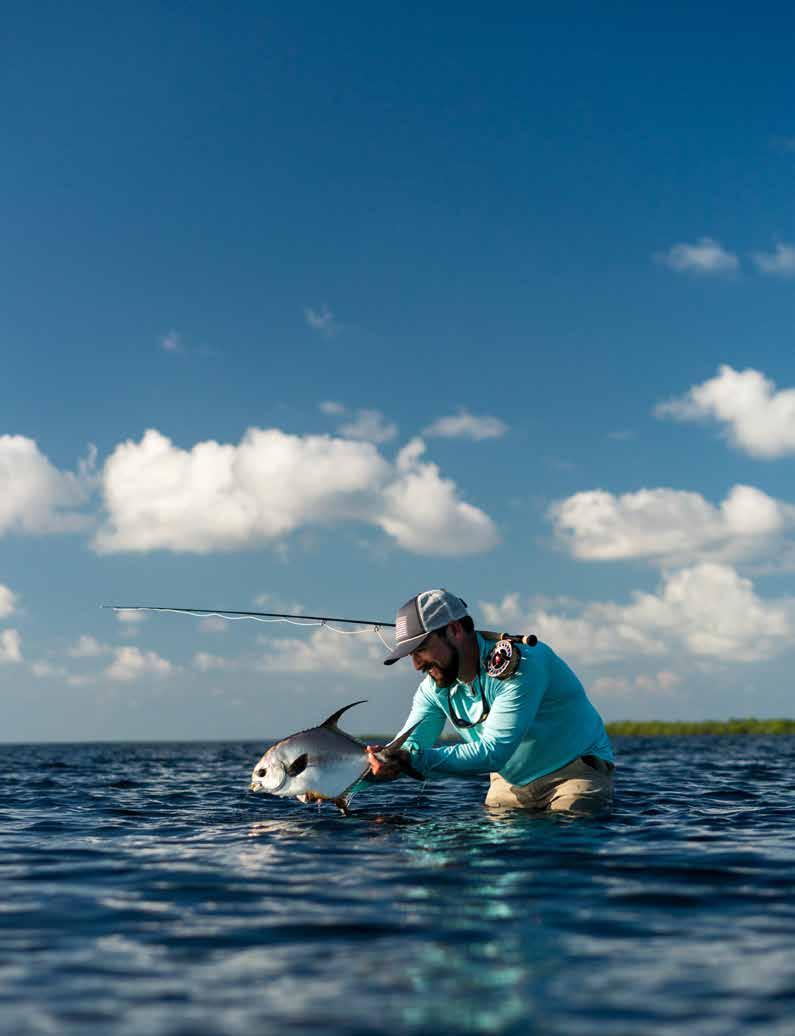
Since 1969, our specialists have traveled extensively in search of the best fishing, hunting and leisure destinations worldwide. With your needs and interests in mind, we revisit these locations frequently to ensure that your travel experience is exceptional every step of the way.
Whether traveling with a group of friends, your spouse or family, we can find the right destination based on your specific travel, timing, fishing and budget objectives. Call us today to plan your dream itinerary.
B O N E F I S H & T A R P O N J O U R N A L SPRING 2020 W W W. B T T. O R G 7 Celebrating 50 years! 1-800-245-1950 | www.frontierstravel.com
Photo by Two Fisted Heart Productions
Welcome Aboard

Bonefish & Tarpon Trust welcomes John Johns to the BTT Board of Directors
John Johns is the former President & CEO of Protective Life Corporation, one of Birmingham, Alabama’s largest companies. His affiliation with the company began in 1993, when he was named Executive Vice President and CFO. After later serving as President and CEO for 15 years, Johns led the $5.6 billion company through its sale to Dai-ichi Life of Tokyo. He was elected Executive Chair in 2017.
A graduate of the University of Alabama, Johns went on to earn the MBA at Harvard Business School and the JD from Harvard Law. His spouse, Dr. Nancy Dunlap Johns, has worked previously as a professor of medicine, a researcher, a healthcare administrator, and as Dean of the UVA School of Medicine. She’s been involved in health policy through positions with the National Governors Association, the Institute of Medicine in Washington, DC, and as a Robert Woods Johnson Health Policy Fellow assigned to work on the reauthorization of FDA legislation and health-related issues in the US House of Representatives. Together, they are avid anglers who enjoy fishing in the Bahamas.
John and Nancy have been generous supporters of BTT’s mission and its Bahamas Education program, including new catch and release videos and other educational materials now widely used in the Bahamas.
Maggie Winchester to serve as BTT Education Coordinator
Maggie Winchester grew up in Vermont, where she often fished with her family. She received the BS in marine biology from the University of New England and the MS in marine biology from the University of Massachusetts Dartmouth, where she also worked as a teaching assistant. Between degrees, she spent a year working at the Cape Eleuthera Institute in the Bahamas as a research technician and research assistant, and taught a research methods class focusing on shark research.
Winchester has collaborated on numerous education initiatives focused on shark research, including outreach with The Gills Club and field courses with Shoals Marine Laboratory, and developed a virtual reality lesson plan with Google Expeditions. She believes that education and effective science communication are crucial in conservation. As BTT’s new Education Program Coordinator, Winchester is creating and distributing to teachers a comprehensive school curriculum that uses flats fish as a way to teach students about ecology and conservation. She will also be implementing additional outreach and field experience opportunities. With an initial focus in South Florida, the BTT Education Program will quickly expand to cover the entire region, including the Bahamas, Belize, and Mexico.
“I am delighted and thankful for the opportunity to deepen my engagement with the Bonefish & Tarpon Trust through board service,” John said. “I wholeheartedly support and embrace BTT’s mission and the collaborative, science-based framework it employs to preserve and restore our precious near-shore marine habitats. I also look forward to meeting and working with other

 BTT Education Coordinator Maggie Winchester. Photo courtesy of Maggie Winchester
New BTT board member John Johns. Photo courtesy of John Johns
BTT Education Coordinator Maggie Winchester. Photo courtesy of Maggie Winchester
New BTT board member John Johns. Photo courtesy of John Johns
Dr. Addiel Perez named Belize-Mexico Program Coordinator
As the Belize-Mexico Program Coordinator, Dr. Addiel U. Perez will lead BTT’s expansion of conservation efforts in the region. He joins BTT after completing his Ph.D. on bonefish movements and prespawning site identification in northern Belize and southern Mexico.
Dr. Perez was born in the small fishing community of Sarteneja in northern Belize. His experience in the lobster and conch fisheries with his father during his early years set the stage for his life goal: contribute to the sustainability of fisheries resources while improving the lives of those who reside in coastal communities.
Dr. Perez’s integration into conservation and management began in 1997, when he volunteered and trained with many local and international researchers that collaborated with non-government organizations, such as Program for Belize, Belize Audubon Society, and Coastal Zone Authority and Institute. After earning an associate degree in marine science, followed by a bachelor’s degree in biology, he worked for a year in the Mesoamerican Barrier Reef System Project before becoming manager of the South Water Caye

Belize-Mexico Program Coordinator
Marine Reserve in 2006. Dr. Perez went on to earn an interdisciplinary master’s degree in natural resources and rural development with a focus on management in Mexico. While working on his master’s degree, he characterized the recreational-sport fishing of Belize using a Mixed-Methods Approach. He also used this approach in combination with tagging to understand bonefish movements and identify pre-spawning sites during his Ph.D. studies.
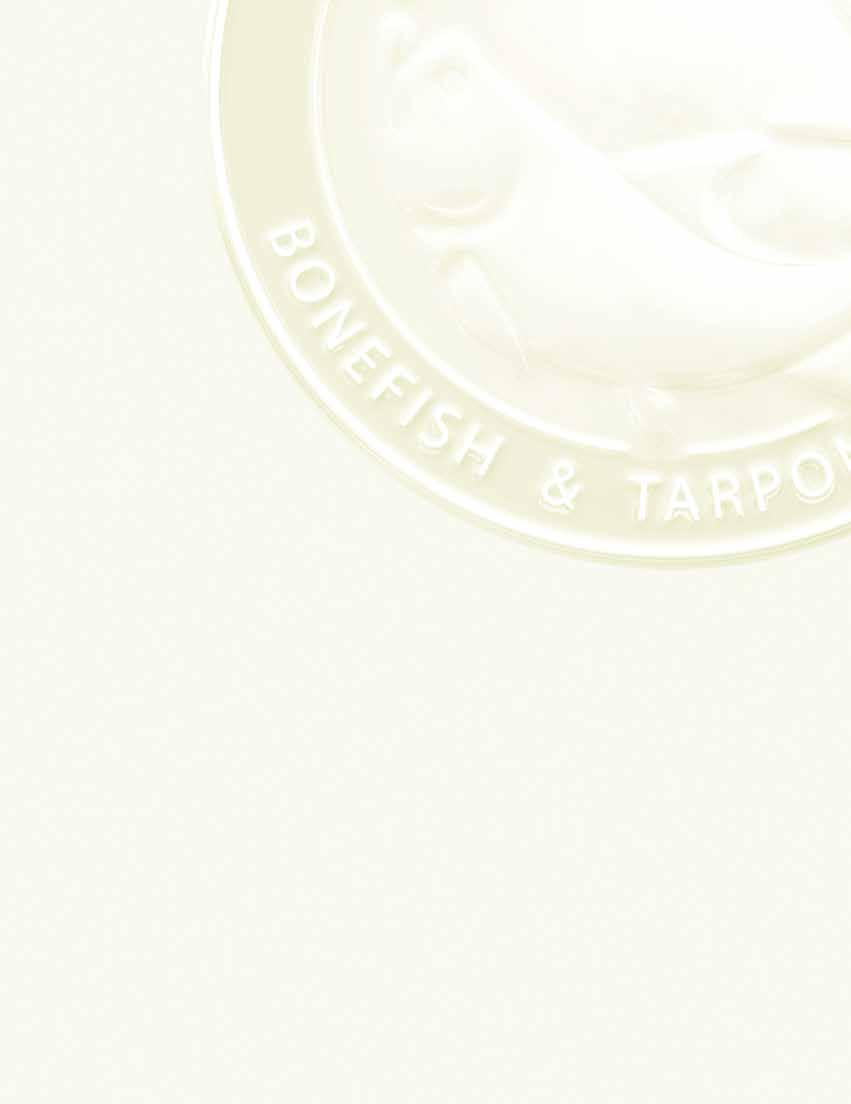
“BTT is proud to have a scientist with such close ties to the region’s fisheries and communities lead the expansion of BTT’s conservation efforts in Mexico and Belize, where BTT began working in 2006,” said BTT President and CEO Jim McDuffie. “This approach will focus on the social, cultural, economic, and ecological connections that must be understood to ensure a healthy flats fishery for the future.”
 BTT
Dr. Addiel Perez conducting research in Xcalak, Mexico. Photo: Patrick Williams
South of Ambergris Caye, Belize. Photo: Scott Morrison
BTT
Dr. Addiel Perez conducting research in Xcalak, Mexico. Photo: Patrick Williams
South of Ambergris Caye, Belize. Photo: Scott Morrison
Tippets
Short Takes on Important Topics
7TH INTERNATIONAL SCIENCE SYMPOSIUM
Please mark your calendar and make plans to attend the Bonefish & Tarpon Trust 7th International Science Symposium and Saltwater Flats Expo on November 13 - 14, 2020, at the Bonaventure Resort & Spa in Weston, Florida. The theme of the Symposium will be Conservation Connections. Stay tuned to BTT.org/symposium for details.
SUPPORT FOR BAHAMAS RECOVERY
In the wake of Hurricane Dorian, the most powerful storm to ever hit the Bahamas, BTT and the Bahamas National Trust (BNT) established the Hurricane Dorian Relief and Recovery Fund to benefit fishing guides, lodge staff and others in the Bahamas’ fishing industry who have been impacted. The fund raised more than $350,000 and is multi-faceted, providing immediate support to relief efforts, followed by support of long-range recovery, including promoting the recreational fishing industry as guides and lodge staff return to work. Additionally, BTT and BNT are working together to assess the mangrove damage from Dorian, which will guide mangrove restoration efforts in important bonefish habitats.

TAGGED PERMIT RECAPTURED FOUR YEARS LATER
Catching a permit on fly is arguably the most challenging and rewarding endeavor in fly-fishing. Though these fish are found throughout the Caribbean, the Florida Keys are the epicenter for catching trophy permit, with 33 of the 36 fly-caught world records occurring in Florida Keys waters. Project Permit, sponsored by Costa Del Mar with support from the March Merkin tournament, seeks to protect and, whenever possible, improve the Keys’ iconic permit fishery.
An ongoing program of Project Permit is our mark-recapture study, which relies on anglers and guides to tag, release, and recapture these special fish. The study has shed new light on permit growth rates as well as their movements and migrations. The resulting data are critical to setting sustainable harvest regulations and ensuring that management zones, like the Special Permit Zone, are effectively protecting the Keys’ fish.
Recently, Key West Captain Nick LaBadie of Tailing Water Expeditions and angler Josh Basgall recaptured a tagged permit estimated to weigh 14 pounds. The fish was tagged by Captain Don Gable and angler Mike Ward four years ago in 2015. The permit was recaptured only five miles away from where it was tagged, and it nearly doubled in size over the four years. Fast-growing fish generally make for a more productive and sustainable fishery. BTT thanks Costa Del Mar, the March Merkin, and all the guides who have donated their time to tag permit and report recaptures.

TARPON ACOUSTIC TAGGING UPDATE
In 2016, BTT launched the five-year Tarpon Acoustic Tagging Project in partnership with UMass Amherst and Carleton University. Sponsored by Maverick Boat Group, the study seeks to broaden our understanding of tarpon movements and habitat use. The results will inform future conservation measures, including the protection of important habitats, addressing water quality issues, and improvements to the management of the fishery. Unlike satellite tags, which often detach from tarpon after a few months, acoustic tags are surgically implanted in the fish’s abdomen and have a battery life of five to seven years. And unlike satellite tags, which are large and require the fish to be 100 pounds or more, acoustic tags can be implanted in tarpon as small as five pounds and as large as 200 pounds, allowing scientists to study fish in a wide range of size and age. Every time a fish swims near an underwater receiver, a unique sonic code is recorded. BTT has deployed nearly 100 receivers and, through reciprocal agreements with researchers studying other species, has tapped into a vast network of more than 4,000 receivers stretching from the Gulf of Mexico to Chesapeake Bay. As scientists detect tagged tarpon on their receiver networks, they share data with BTT.
To date, BTT has tagged 172 tarpon, most of which were caught in the Florida Keys. Others were tagged in Apalachicola, Charlotte Harbor, Tampa Bay, Georgia, South Carolina, and Texas. These fish, which range in size from 10 pounds to 165 pounds, have produced more than 172,000 detections to date, providing BTT scientists with valuable new insights into the fishery. Although this project
10 B O N E F I S H & T A R P O N J O U R N A L SPRING 2020 W W W. B T T. O R G
is not yet complete, BTT is already using early findings to support conservation and management efforts. In late 2019, BTT used tracking data on migrating tarpon to advocate for greater protection of the species in North Carolina. BTT spoke at the NC Marine Fisheries Commission in support of an amendment to an existing regulation that would make the species catch and release only in state waters.
BTT MONITORS BONEFISH PRE-SPAWNING ACTIVITY IN BELIZE
Bonefish is one of three species that supports Belize’s flats fishery, which generates more than $56 million (USD) for the nation annually. Bonefish in Belize are also important to Florida, as larvae from spawning sites in Belize drift to the Florida Keys. This past November and December, BTT’s Belize-Mexico Program Manager, Dr. Addiel Perez, worked with personnel from Hol Chan Marine Reserve and several stakeholders, including Omar’s Freelance Fishing and El Pescador Lodge and Villas, to study a bonefish pre-spawning aggregation (PSA) site. The joint monitoring of two bonefish PSAs in Belize began two years ago. This year an additional two PSAs were documented. Identifying such sites for protection is important, because bonefish are most vulnerable during their pre-spawning migration and in PSAs.
The threats to bonefish on their migrations and in the PSAs are illegal harvest (bonefish are catch and release only in Belize), recreational fishing of the PSAs, habitat degradation of the PSA sites, and recreational activity. Fishing PSAs is tempting because there are so many bonefish in one place but is discouraged because these fish are especially vulnerable to being eaten by predators while hooked or after being released. Habitat degradation, such as
dredging and dock construction, makes the PSA sites unusable for bonefish. Recreational activity around the PSAs, such as boating or jet ski traffic, disturbs the fish and can prevent them from spawning. Stay tuned to BTT.org for updates on bonefish PSA identification and monitoring in Belize and Mexico.
BTT VOICES SUPPORT FOR ATLANTIC MENHADEN
In a letter submitted to Wilbur Ross, Secretary of the U.S. Department of Commerce, BTT joined with other leading conservation organizations and industry leaders in expressing support of Atlantic menhaden, an important forage fish for tarpon. Ross agreed on December 19 with BTT and partner organizations that foreign-owned Omega Protein was willfully violating the fishing cap on menhaden and will require compliance by the State of Virginia.
WIN THE FLY-FISHING TRIP OF A LIFETIME
The winner of BTT’s annual members-only drawing and his/her guest will enjoy four nights at Red Bays Sunset Lodge on Andros’ famed northwest coast and three days of guided flats fishing with the lodge’s team of experienced guides. Located a few miles north of the historic sponge settlement of Red Bays, the lodge was built in 2018 by Benry Smith, son of legendary guide Charlie Smith, also known as Crazy Charlie. The six-person operation specializes not only in trophy bonefish anytime of year, but also resident tarpon and occasional large permit during the warmer months. If you prefer to wadefish for bones, the expansive, hard white sand flats of the Joulter’s Cays is only a short 15 minute boat ride from the lodge. All dues-paying BTT members who join or renew during 2020 will be automatically entered to win, with the drawing taking place on January 7, 2021. (Photo below).
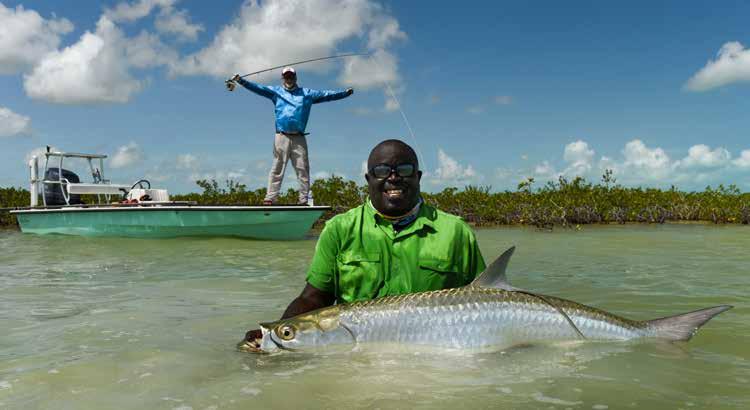
B O N E F I S H & T A R P O N J O U R N A L SPRING 2020 W W W. B T T. O R G 11
Red Bays Sunset Lodge offers fishing for resident tarpon. Photo courtesy of Yellow Dog Flyfishing Adventures

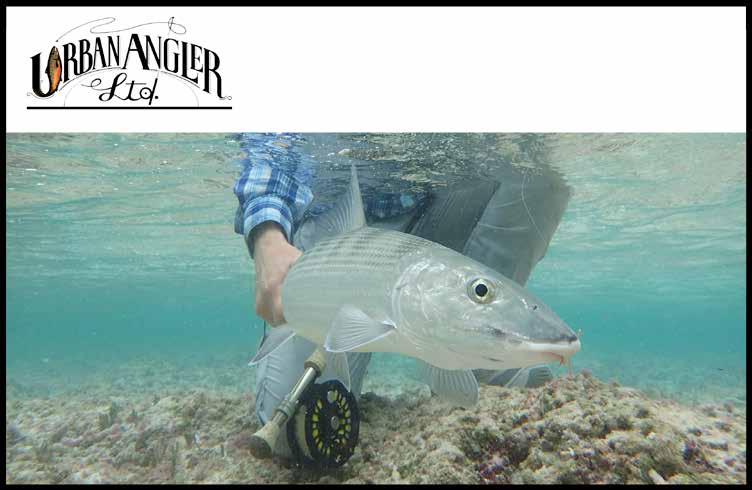

12 B O N E F I S H & T A R P O N J O U R N A L SPRING 2020 W W W. B T T. O R G
MILLER RANCH ON THE RUBY RIVER
Alder, Montana
304± ACRES | $4,750,000
Invest & Enjoy
Fay Ranches supports Bonefish & Tarpon Trust’s efforts to conserve and restore flats fisheries and the habitats that support them.
Greg Fay, Founder/Broker, Fay Ranches Board of Directors, Bonefish & Tarpon Trust




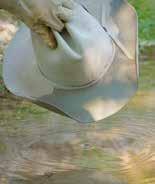

LAND INVESTORTM VOLUME 5 REPUBLIC RANCHES
FAYRANCHES.COM | INFO@FAYRANCHES.COM | 800.238.8616 To view details on over $850m worth of exclusive listings and a complimentary subscription to Land Investor magazine visit us at:
BTT Responds to the Florida Keys National Marine Sanctuary’s Proposed Management Plan

The Florida Keys National Marine Sanctuary, governed by the National Oceanographic and Atmospheric Administration (NOAA), is one of five management agencies charged to conserve our fish and their habitats in the Florida Keys. The Sanctuary’s boundary surrounds Monroe County, Biscayne Bay to the north, and west of the Dry Tortugas. The mission of the Sanctuary is to balance human activities in the marine environment with the conservation of fish and wildlife and the habitats that support them. To achieve its mission, the Sanctuary limits marine activities that stress and/or damage environmentally sensitive habitats. To limit damaging marine use, policymakers draw boundaries around these important areas and then use regulatory tools such as “Idle speed,” “No anchor,” “No motor,” “No entry,” and “No fishing” zones to reduce stress on those places.
When done properly, this management approach can benefit our Florida Keys flats fisheries. For instance, flats that are regularly run across by vessels, which impact fish behavior and can cause habitat damage, can be designated as “Pole/troll” zones (prohibit use of combustion engines). “Pole/troll” zones allow flats fishing via poling and the use of trolling motors, while diverting other traffic away from our important flats.
Last August, the Sanctuary released for public comment its draft management plan, A Restoration Blueprint, which will govern where we can go and how we can use certain areas within the Florida Keys for at least the next 10 years. The Sanctuary proposes over 50 new marine zones, ranging from “No entry” zones to “No anchor” zones, and is now asking for public comment to help revise this draft management plan.
Informed by science, BTT submitted its response to the Sanctuary’s proposoed management plan. First and foremost, we believe that marine zoning regulations within the new management plan should facilitate flats fishing. This is because flats fishing is low environmental impact and is compatible with Sanctuary conservation goals, and is a long-standing fishery in the Florida Keys with high economic impact. Flats fishing leaves almost no marine debris, there is little to no bycatch, the fishery is regulated as catch and release, noise stress on nesting or roosting birds is minimal, and flats boats are less damaging to seagrass and other habitat-forming species because they have a shallower draft than many other vessels and the fishing is done by poling and with trolling motors.
In general, zones that benefit our flats fishery occur in ecologically important areas, such as spawning sites, juvenile habitats, and foraging and resting grounds. Zones also must be big enough to match the movements of the fish. Based on our research in the Bahamas, for example, adult bonefish need approximately 2,000 acres of healthy habitat as a home range, and thus to sustain an area important to fishing. Therefore, marine zones intended to protect habitats important to bonefish should be within that size range. To provide a scale of reference, Coupon Bight is approximately 2,000 acres.
In our response to the Sanctuary, BTT summarized the proposed zones we support, those we oppose, zones that should be revised, and additional zones to be added to protect our vital flats habitats and allow for recovery of the flats fishery.
14 B O N E F I S H & T A R P O N J O U R N A L SPRING 2020 W W W. B T T. O R G
Anglers fishing the flats of Key West, Florida. Photo: Ian Wilson

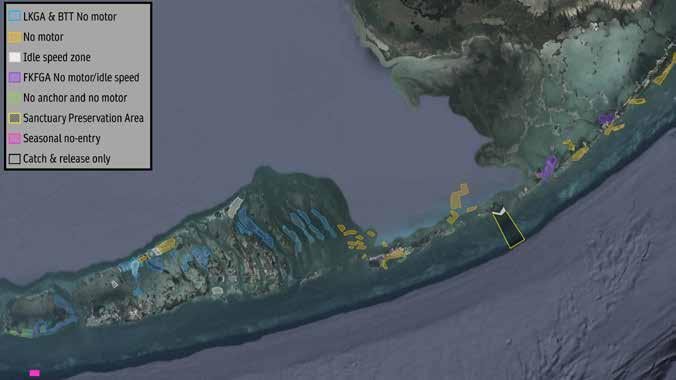
The map depicts the various pole/troll zones, idle speed zones, catch and release only zones, and spawning season closure zones that Bonefish & Tarpon Trust supports. These zones are science-based and will improve the flats fishery if they are included in the Sanctuary’s management plan.
ZONES WE SUPPORT
BTT supports all “No motor” zones and “Idle speed” zones proposed in the Sanctuary’s management plan. These 15 zones are scattered throughout the Florida Keys National Marine Sanctuary, with notable proposed “Idle speed” zones occurring on the flat east of Content Keys in the Lower Keys, Jack Tar Flat on the ocean side of Marathon, and more expansive “No motor” zones on Snake Creek and Tavernier Creek flats in the Upper Keys. These regulations should direct activities that damage shallow water habitats to deeper water. At the same time, “No motor” and “Idle speed” zones will allow flats fishing. And these zones are expansive, providing the needed protection to ensure that bonefish and other flats species can go through their dayto-day lives with fewer disturbances.
ZONES WE OPPOSE
The Sanctuary proposes over 30 “No entry” and “Transit only” zones in the shallow waters of the Florida Keys that would ban fishing in those areas. Many of these zones overlap with productive flats that support bonefish, permit and tarpon. The three most critical “No fish” zones occur on Redbay Bank and Channel Key Bank (transit only), and on the Atlantic shoreline on Long Key. No available science shows that flats fishing (push poling or the use of a trolling motor) has adverse impacts on wildlife and habitats that these “No entry” zones are meant protect. Therefore, restricting access to flats fishing conflicts with federal acts, regulations or executive orders stating that if a specific type of angling is found to be compatible with resource conservation, government agencies have a responsibility to facilitate
B O N E F I S H & T A R P O N J O U R N A L SPRING 2020 W W W. B T T. O R G 15

it. In our statement, we urge the Sanctuary to re-zone these places to allow for flats fishing, as flats fishing does not conflict with Sanctuary management goals.
ZONES NEEDING REVISION: WESTERN DRY ROCKS
A critical spawning site in the Keys, Western Dry Rocks (1.3 square mile area or 600 football fields), is proposed to be zoned as “Trolling only” to reduce fishing pressure on spawning fish. Our research demonstrates that Western Dry Rocks is likely the most important spawning site for permit in the Lower Keys. Unfortunately, angler reports and research suggest that an unsustainable number of hooked permit are eaten by sharks before they are landed. BTT is calling on the Sanctuary to reconsider the “Trolling only” designation. Depending on how “trolling” is defined, anglers may still be able to fish for spawning permit. Instead, we suggest a spring-summer seasonal closure at Western Dry Rocks. Of the seven fish species that spawn there, all spawn between April and August, and four, including permit, only spawn within that window. This seasonal closure would allow winter fishing activities within the Western Dry Rocks Wildlife Management Area, which due to its geographic position provides fishing opportunities during strong northern winds common in the winter.
ZONES THAT NEED TO BE ADDED
Overall, the Sanctuary’s “Restoration Blueprint” provides a framework to protect our flats fishery, but the plan needs more zones to reduce stress on shallow waters. We encourage the Sanctuary to include marine zoning recommendations proposed by the Lower Keys Guides Association (LKGA) and Florida Keys Fishing Guides Association (FKFGA). LKGA and FKFGA zones were designed based on the expertise of over 180 fishing guides identifying areas that are
critical to sustaining the flats fishery. For instance, LKGA recommends the historic flats west of Key West where numerous world record permit have been bested, like Del Brown’s all-tackle world record permit, be zoned as “Pole-troll”/ “Idle speed.” Likewise, FKFGA recommends the Islamorada flats responsible for producing more world record bonefish than anywhere else in the world be regulated as “Pole-troll”/ “Idle speed.” LKGA and FKFGA proposed zones are expansive (nearly all of their proposed zones are greater than 2000 acres), which provides conservation at a scale appropriate to flats fish movements. Affording these areas additional protection is essential to the flats fishing industry and the conservation of the species. To augment LKGA and FKFGA recommendations, we also propose an additional four “Pole/troll” zones east of Annette Key. In a similar fashion with LKGA and FKFGA recommendations, these zones occur in productive bonefish, permit and tarpon areas and provide conservation at a scale that matches the ecology of the fish. In addition, these zones satisfy the mission of the Sanctuary by protecting habitats.
CONCLUDING THOUGHTS
The Sanctuary is looking for the right balance between human use of the marine environment and conservation. The first part of this process concluded on January 31. In the next few months, the Sanctuary will release a revised management plan and will take public comment for a second time. As we wait for the release of the revised management plan, we urge readers to learn more about our position statement at BTT.org and consider submitting a public comment when the time comes. We will continue to work hard to see the needed changes added to the final draft of the management plan.
16 B O N E F I S H & T A R P O N J O U R N A L SPRING 2020 W W W. B T T. O R G
Seagrass is an essential component of the Florida Keys flats fishery. It holds the sediment in place, and gives shelter to prey that feed bonefish, tarpon, and permit. Photo: Ian Wilson
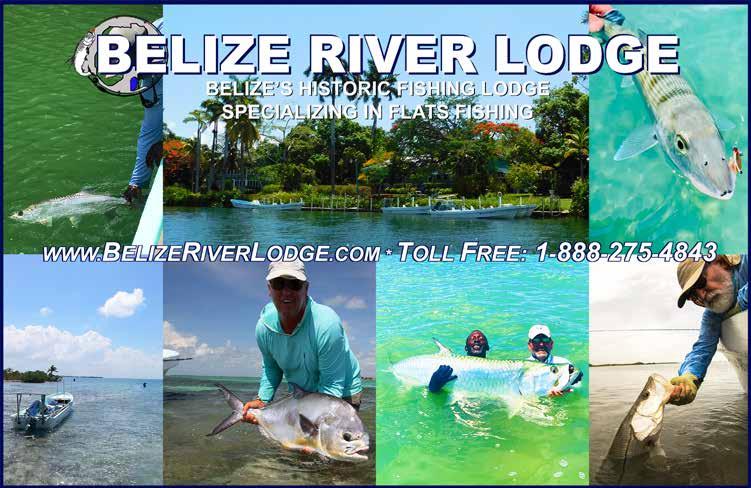



SUNBRELLA.COM Design + Performance ™ is a trademark, Legendary Performance Fabrics ® and Sunbrella ® are registered trademarks of Glen Raven, Inc. LEGENDARY PERFORMANCE FABRICS ® FADE PROOF / EASY CARE / BLEACH CLEANABLE
Teaching the Next Generation of Flats Conservationists
MAGGIE WINCHESTER
EDUCATION COORDINATOR, BONEFISH & TARPON TRUST

Education is a powerful tool that can make people of all ages passionate about science and conservation. Scientific studies can result in incredible discoveries, but these discoveries have little effect if nobody shares them. With effective education, these discoveries can change social perspectives and even influence laws. In the case of the declining flats fishery, solutions, such as promoting good catch-and-release fishing practices and restoring important coastal areas, take large-scale cooperation that requires an educated public and policymakers working together. After all, restoring the flats benefits more than just anglers; healthy flats allow us all to enjoy more of what the ecosystem has to offer—while also sustaining a multi-billion-dollar recreational fishery.
Education has always been a key component of BTT’s mission. In the last four years, BTT’s Bahamas Initiative has used classroom lessons and hands-on research experiences to get students across the Bahamas involved in flats research and conservation. Building on the success of these efforts in the Bahamas, BTT has established a formal education program, which we are developing with advice from collaborators and input from teachers and educators in Florida. The program will use bonefish, tarpon, permit, and snook as tools to
teach students about larger environmental and ecological issues. Its primary goals are to educate the next generation about the threats and challenges facing the flats fishery and provide them with the knowledge needed to conserve and restore it.
A central component of BTT’s Education Program is the Flats Ecology Curriculum, which will be taught in school systems beginning with Monroe County (The Florida Keys). With lesson plans designed by scientists and educators for students in grades 2-12, the Flats Ecology Curriculum focuses on the importance of bonefish, tarpon, permit and snook, and the places they live. Fun readings and activities cover important topics that fit Florida state standards, making the lessons easy for teachers to use, while using the flats ecosystem as a model to show students why conservation is important.
Beyond the curriculum, we are also getting kids excited about conserving the flats in other ways. Learning in the classroom is important, but nothing compares to being out on the water. Involving kids in research—like dragging a seine net through knee-deep water, hoping to collect juvenile bonefish—ignites an energy and passion that often inspires students to pursue a new interest or even a
18 B O N E F I S H & T A R P O N J O U R N A L SPRING 2020 W W W. B T T. O R G
Justin Lewis, BTT Bahamas Initiative Manager, teaches students at Eco-Camp on Andros how to tag a bonefish. Photo: Nina Sanchez
potential career. And of course, there is nothing more inspiring than hearing a child say, “That was my first fish.”
BTT will continue to expand its hands-on education in the Bahamas while similar programs begin in Florida, Belize and Mexico. These programs will focus on teaching kids about the flats ecosystem—what it is, the current threats and proposed conservation solutions—while
they get to see and experience it for themselves. In addition, the BTT Education Program is exploring ways of using the latest technology to let students experience the flats without leaving the classroom, such as virtual and augmented reality, which would make experiential learning more accessible to inland schools and schools with limited funding. Stay tuned for more updates on our website and in future issues of the Journal

Education Activity: Biodiversity
BTT’s Education Workbook is packed with activities for children. For the child in your life who likes learning about nature, we’ve included a sample activity below that will take you outside to learn and explore together.
Biodiversity—the number of different species living in an area—is important for ecosystem health. A “biodiverse” ecosystem (one that is full of many different types of life) is often very healthy, because every different plant or animal is contributing something important to the ecosystem. For example, a healthy, diverse ecosystem may have bees that pollinate, plants that provide shade, or lizards that eat insects. Diversity also makes an ecosystem resilient; if you have many different types of plants living in a place, some of them are bound to survive even when disaster, like a hurricane, strikes.
When trees are cut down, land is added or removed, or humans change the ecosystem in some other way, ecosystems lose many of their different species. In this activity, you and your child will be observing the biodiversity of these ecosystems—and how humans can impact biodiversity—together.
Activity: You and your child will be visiting two different habitats. The first is undisturbed by human development, such as national parks, mangrove creeks, clean ponds or lakes, or live coral reefs. The second habitat is directly influenced by humans, such as areas around marinas, popular beaches, bleached/algae-covered coral reefs, human-altered channels or canals. During your explorations, be sure to be respectful of your environment, whether looking for birds, observing plants, or fishing.

BTT’s Standardized Youth Education Workbook is one of many resources for educators teaching BTT’s Flats Ecology Curriculum.
Get your guidebook or smart phone! Try to identify birds, plants, or fish (or all three!), record them in a notebook, and for anything you cannot identify, count as “unknown bird #1, #2, etc.” or “plant, fish, etc.” Your list may look something like this:
• Pelican: 2
• Mangrove snapper: 8
• Unknown small fish: 3
Do this for both ecosystems you visit. Do you notice differences in the number of species you can find? Use your findings to help your child (and fledging scientist) understand the importance of biodiversity, and how human actions often make habitats less diverse.

B O N E F I S H & T A R P O N J O U R N A L SPRING 2020 W W W. B T T. O R G 19
Students in Grand Bahama explore a bonefish flat with Justin Lewis, BTT Bahamas Initiative Manager. Photo: Nick Roberts
This food web graphic is an example of the educational materials found in BTT’s Standardized Youth Education Workbook.
Solving the Bonefish Puzzle: Honing in on Keys
BY HEATHER RICHIE
Bonefish Spawning Sites

20 B O N E F I S H & T A R P O N J O U R N A L SPRING 2020 W W W. B T T. O R G
Near the full moon from fall to late spring, bonefish congregate nearshore by the thousands to form prespawning aggregations, known as PSAs. The fish porpoise at the surface to gulp air before swimming offshore at night. Together the bonefish dive to more than 250 feet in water that is thousands of feet deep before surging back up toward the surface. Scientists believe that the rapid change in pressure during the ascent causes the fishes’ airbladders to expand, which helps to expel their eggs and sperm. The eggs hatch in about a day, and the larvae drift in the open ocean for one to two months before transforming into juveniles in sandy or muddy bays.
The complex bonefish spawning cycle is an epic feat of nature, about which little was known until recent years. “The characteristics of bonefish spawning sites were not even clear until 2011, when colleagues first documented a site in the Bahamas,” said Dr. Ross Boucek, BTT’s Florida Keys Initiative Manager. “And even as Keys guides and anglers experienced a downturn in the Keys bonefish fishery, the Bahamas’ world-class bonefish fishery remained healthy, so it has served as a great laboratory for us to learn more about bonefish spawning.”
BTT and its partners have located numerous bonefish PSAs in the Bahamas and along the Belize-Mexico border, but the spawning sites of bonefish in the Florida Keys have remained a mystery since BTT was founded more than 20 years ago in response to the decline of the Keys’ bonefish fishery in the 1990s. Early work to find PSAs in the Keys did not bear fruit, but parallel research succeeded in the Bahamas. BTT is now applying this new knowledge from the Bahamas in a renewed push to find PSAs in the Keys.
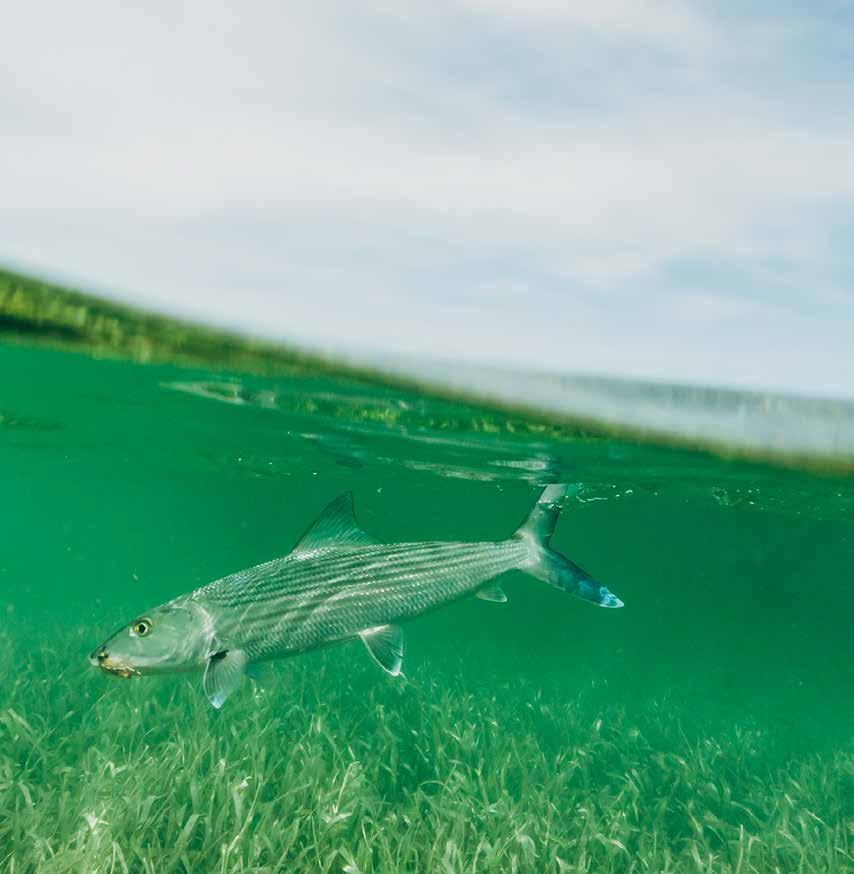

B O N E F I S H & T A R P O N J O U R N A L SPRING 2020 W W W. B T T. O R G 21
Dr. Boucek implants an acoustic transmitter into a bonefish’s abdominal cavity.
Photo: Ian Wilson.
A Florida Keys bonefish. Photo: Austin Coit
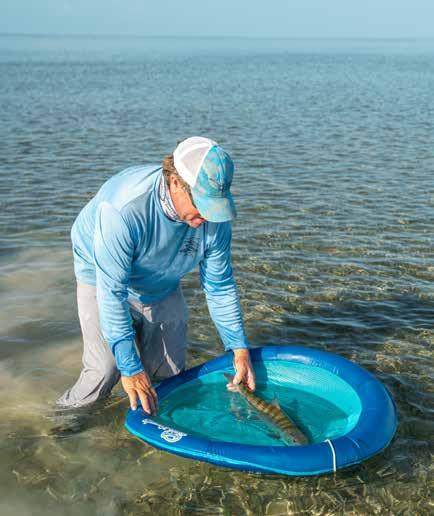
“Since the spawning success of bonefish is essential to a healthy population, finding where bonefish spawn in the Keys and then working to protect those sites is an important focus of BTT’s Keys Initiative,” said Dr. Boucek. “The discovery of bonefish PSAs here in the Keys would be unprecedented and would mark a huge step forward in our conservation efforts.”
Dr. Boucek is in the midst of his first season of tagging bonefish for a new three-year study in the Florida Keys. Much of the study is modeled after the Bahamian research that continues to locate and document bonefish PSAs. While a perfect storm of factors, such as water quality decline, habitat loss and degradation, pollution, lack of larvae from distant spawning sites, poor juvenile bonefish survival, and past poor fish handling practices has contributed to the decline of the Keys fishery, another factor might be that not enough bonefish are spawning in the Keys. Finding PSAs in the Keys is essential to determine if bonefish are spawning locally or if most of the larvae are coming from areas outside the Keys.
Part of the year Dr. Boucek works by moonlight in what has to be the most romantic job in bonefish conservation. The study is taking place at the Ballast Key field station, with Dr. Boucek and a team of researchers from BTT and Florida International University spending six days leading up to the full moons in November, January, and March. While at the station, they are running transects in four- to eight-foot deep areas to attempt to identify pre-spawning sites. They are looking for bonefish rising for air, large schools swimming near the surface, and high numbers of sharks and other predators. Drones
are used in light of Bahamian studies which had more success with this method than sonar, with researchers following some 300 feet behind in a center console boat. Each day in the field from mid-afternoon onward, the team collects roughly 80 minutes of footage in 20-minute segments to examine for telltale signs of PSAs.
There has been good news for Keys bonefish fans in the last few years. A surge of small bonefish reappeared on some Keys flats providing new, welcome fishing opportunities. But a big question remains: where did these fish come from?
“There are a lot of bonefish around in three different sizes, all born a year apart from one another,” said Dr. Boucek. “Starting in 2014, a new wave of babies came in, followed by two more new generations in 2015 and 2016. The size classes are approximately 15 to 18 inches (2016 fish), 18 to 20 inches (2015 fish), and 22 to 25 inches (2014 fish).”
BTT’s extensive Bonefish Genetics Study, concluded in 2018, found that a significant portion of Florida Keys bonefish came from spawning in Belize, Mexico, and southwest Cuba. This means that although not all bonefish are locally spawned, it’s likely that the majority are. Conserving this Florida population, and its spawning sites, will be crucial to long-term bonefish restoration in the Keys. Otherwise, the Florida fishery will limp along—at less than half of its historic numbers—utterly dependent on fish spawned “upcurrent” and outside the U.S.
“We hypothesize that bonefish migrate to spawn west of Key West because if they spawn there, many of their larvae will remain in the Keys.” said Dr. Boucek. By catching 30 adults (10 each in the Upper, Middle, and Lower Keys) and quickly implanting an acoustic transmitter the size of a AA battery into each one’s abdomen before releasing the fish back into the wild, Dr. Boucek can monitor the movements and habitat use of the tagged bonefish in hopes that they will lead him to yet undiscovered spawning sites. BTT and other research organizations have thousands of acoustic receivers moored to the ocean floor around the Keys. When a tagged bonefish swims by one, the date and time is recorded by the receiver.
As the study progresses, it might become possible to detect if bonefish return to the same spawning site, how the decline in habitat is affecting spawning sites, and whether viruses and contaminants play a role. Guides have reported three possible PSAs that Dr. Boucek is in the process of studying. Finding bonefish PSA sites in the Keys is essential to BTT’s strategy to restore and protect the Keys bonefish population. BTT already knows that it has to work internationally to protect the spawners that send new larvae to the Keys every year. Finding a local PSA site will allow BTT to focus on local conservation needs to ensure the fishery can once again become self-sustainable.
Heather Richie is a writer whose special interest is the land traditions—particularly the foodways and sporting—of the modern American and unbordered Souths. She is the author of FULL, A Slim Volume on Southern Foodways.
22 B O N E F I S H & T A R P O N J O U R N A L SPRING 2020 W W W. B T T. O R G
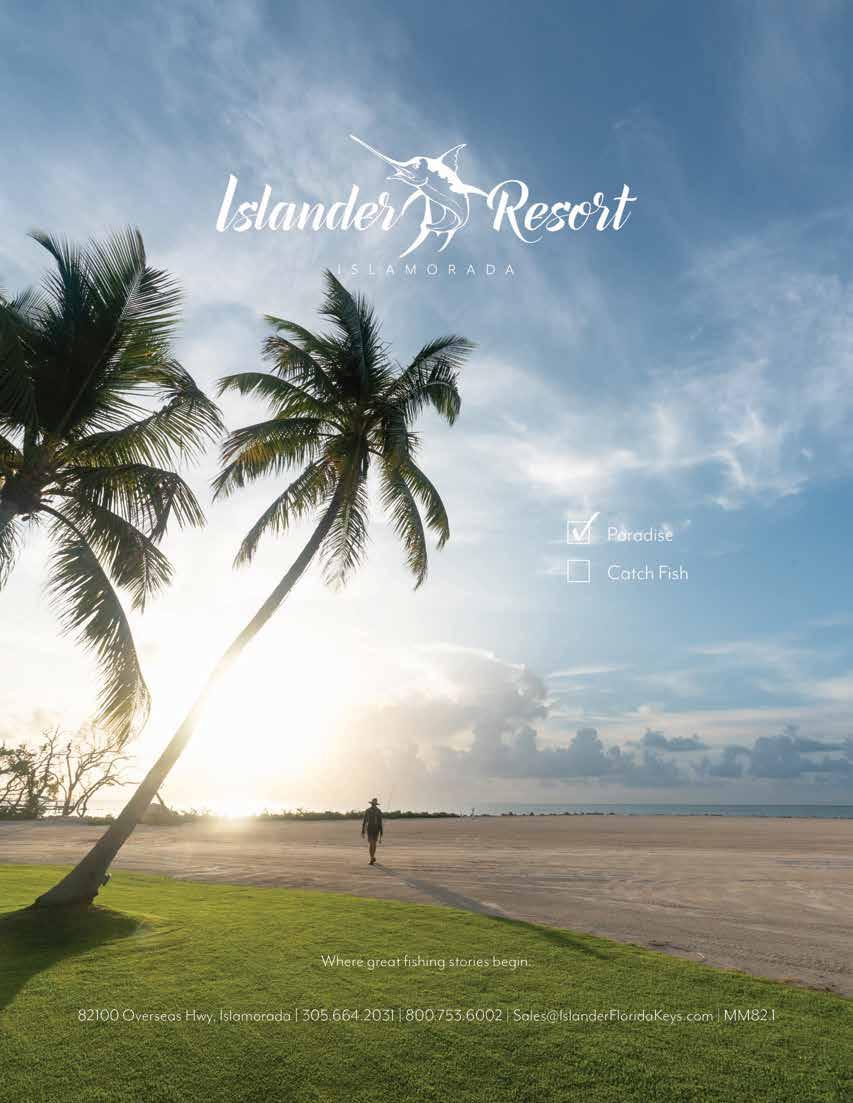
The New Normal: The Destruction and Resilience of the Bahamian fishing community after Hurricane Dorian
BY ASHLEIGH SEAN ROLLE

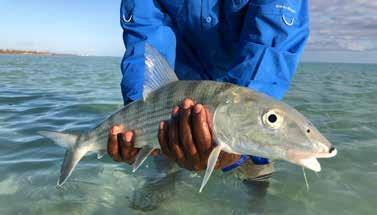
Disaster has never been synonymous with the islands of the Bahamas. Even though hurricanes have always come to the islands and one must always be wary during hurricane season, the Bahamas is marketed as a place as carefree as any child’s dream.
“It’s better in the Bahamas” is a long-used tagline by the country’s tourism department that accompanies pictures and videos of calm shallow waters and a sun that refuses to stop shining.
On September 1, 2019, however, this narrative changed when Hurricane Dorian made landfall, and many northern Bahamians see this as a day that opened the gateway of destruction that will define an entire generation. The world watched the news as Hurricane Dorian tore away at the heart of north Bahamian communities in the Abacos and Grand Bahama, stripping away infrastructure and, irreplaceably, human lives.
The storm sat over Grand Bahama for two days, bringing with it a
storm surge of 25 feet. Seventy-five percent of Grand Bahama was submerged underwater during Hurricane Dorian, and the eastern end of the island stared down the barrel of a gun known as a king tide. It’s safe to say that Hurricane Dorian will forever change the way that Bahamians look at the ocean, especially fishermen and fishing guides who depend on her for their livelihood. Guides like Harryo Bevans, who has spent over 25 years taking visiting anglers out onto the flats, are still on the island, trying to pick up the pieces of a life that may always be haunted by a storm of this magnitude.
When asked what makes East Grand Bahama such a special place, Bevans excitedly stated, “It was one of the best places if you were looking for large fishes and beautiful scenery, lovely flats.” His voice takes on an almost wistful tone as his passion for his community can be heard in the words that create a song that only his memories know the lyrics to. It’s not lost on me, however, that he and many others toggle between referencing East Grand Bahama in the past and
24 B O N E F I S H & T A R P O N J O U R N A L SPRING 2020 W W W. B T T. O R G
A Grand Bahama bonefish. Photo: Justin Lewis

present tense. It’s not a strange concept either. Certain landmarks are gone and the way of life has changed, but he is still very much present within his community. I can only imagine how difficult it must be to refer to something as “was” when your very presence indicates that there is indeed still a present and, in his very own words, hope for a better future. That future will not come without a constant reminder of what was lost, though.
When Dorian began to approach, Bevans ensured that his own family was evacuated. Bevans himself stayed in East Grand Bahama, one of the hardest-hit settlements on the island of Grand Bahama, in the hope of convincing his best friend PJ Thomas and his family to leave. That hope remained just that: Thomas and his family decided to stay. After failing to convince his friend to leave with him, Bevans was forced to ride out the storm for two days in a boat behind his house. The way his voice cracks as he verbally beats himself up for not forcefully evacuating his best friend is a somber reminder of what survivor’s guilt
can do to a person. Thomas and his three children were unfortunately lost to the storm. Still, with all of this weight on his shoulders, Bevans speaks about a future for East Grand Bahama that he knows will be better than the past. As a fishing guide for East End Lodge, he’s holding out for better.
After suffering catastrophic damage, Robert Neher, the owner of East End Lodge in McClean’s Town, is focused on rebuilding. At the same time, he’s painfully aware of concrete challenges he has to face, such as the necessity of rebuilding basic infrastructure, as there is no running water or power. “They’re actually considering putting in diesel generators individually in each settlement and running intermittent rolling power so nobody could even run the creature comforts like AC or running your freezer or refrigerator 24/7.”
Even as Neher mentions this and acknowledges the fact that there will be a long road ahead with major adaptation, he is still pressing forward
B O N E F I S H & T A R P O N J O U R N A L SPRING 2020 W W W. B T T. O R G 25
Brush Cay in East End, Grand Bahama. Photo: Justin Lewis
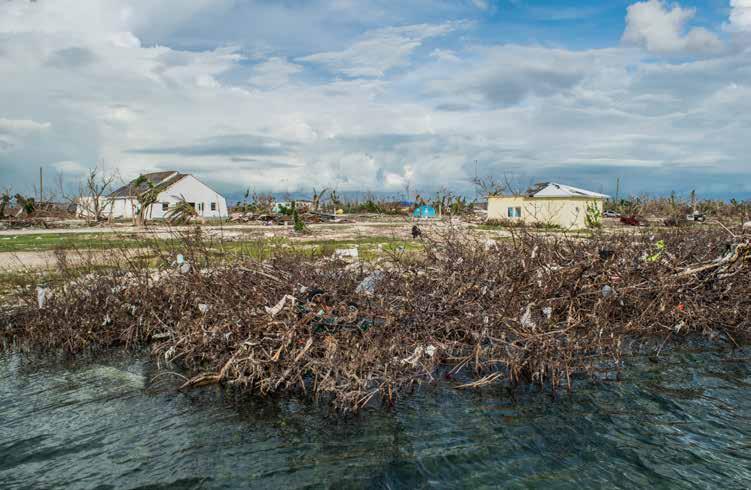
with the hope of having his lodge opened by late spring, a goal he set with his employees in mind. East End Lodge and various donors have been able to provide a small stipend to the employees that covers the basic necessities of food, clothing and rent. Neher knows, though, that the people of East Grand Bahama—specifically those who work at the lodge—would like to get back to work and back to the things that they love to do. “They never say to me, ‘Hey when’s my next check?!’ They say, ‘When can I get back to work? I wanna get back to work.’ So that’s my motivation to get the lodge up and running as soon as possible,” said Neher.
Neher isn’t the only lodge owner with this sentiment. Oliver White from Abaco Lodge in the Abaco Islands has a strong connection to bonefishing in the Bahamas that spans the better part of two decades. His first bonefishing trip was in 2001 and he opened his lodge in 2008.
“Abaco was the perfect blend of out island living with enough infrastructure to make it incredibly comfortable,” said White. “Combine that with pristine, diverse, and unpressured bonefish flats—it was the perfect place to call home.” The infrastructure that White mentions is almost gone. Marsh Harbour in Abaco lost about 90 percent of all structures and saw the highest death toll in the northern Bahamas. Sixty of the 70 confirmed deaths came from the Abaco Islands, not to mention the hundreds more missing. White describes the state of his lodge now as one of complete devastation, saying, “There’s nothing left.” And even with saying this, he holds out hope for a full recovery. “I do think it will recover and get back to normal and hopefully an improved version of itself,” he said. “Rebuilding from the ground up creates an incredible opportunity for improvement and thoughtful development.” With his staff at the forefront of his mind, White’s team

was successful in their fundraising efforts and are paying their staff for an entire year. “We expect to be fully operational again in 18 to 24 months.”
Guides and lodge owners may have high yet hesitant hopes of rebuilding, and we’ve seen what a storm like Dorian has done to the infrastructure. But what about the fish they’re meant to guide us to?
26 B O N E F I S H & T A R P O N J O U R N A L SPRING 2020 W W W. B T T. O R G
East Grand Bahama was devastated by Hurricane Dorian. Photo: Justin Lewis
Residents of East Grand Bahama begin the rebuilding process. Photo: Justin Lewis
“The underwater habitat is still intact—the only habitat that got really impacted was the red mangroves.”
Justin Lewis, Bonefish & Tarpon Trust’s Bahamas Initiative Manager, is eager to indicate that there are still plenty of bonefish around, but that it’s the recreational side of the industry that will take a longer time to bounce back. “The underwater habitat is still intact—the only habitat that got really impacted was the red mangroves.” Mangroves are important because they provide a nursery for juvenile fish, and beyond that they act as a buffer along coastlines during storms. BTT understands the significance of mangroves and the role these plants play in defending the coasts from the impacts of storms like Dorian. Hence they’ve partnered with Bahamas National Trust in a series of Hurricane relief efforts, with one of their important projects being mangrove restoration.
“We’ve been working with Bahamas National Trust since day one; they are our biggest partner in the Bahamas,” said Lewis. “We’ve

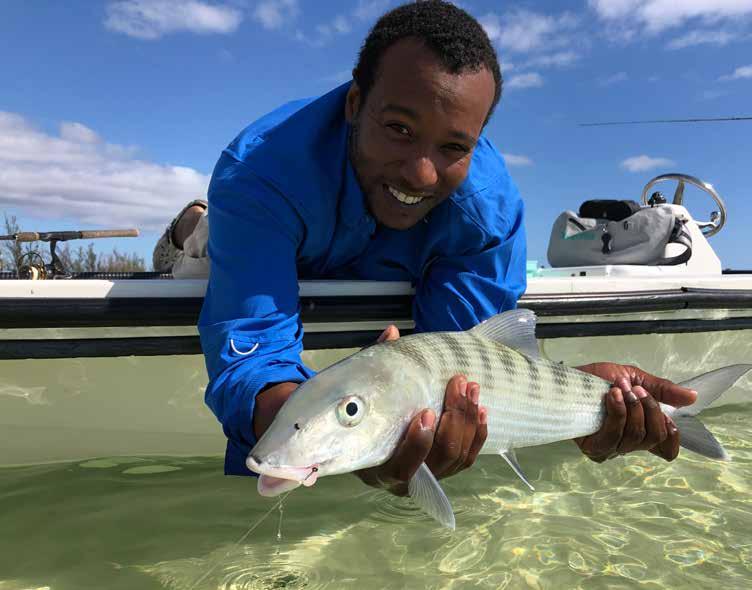
B O N E F I S H & T A R P O N J O U R N A L SPRING 2020 W W W. B T T. O R G 27
Grand Bahama resident Rodney Stuart with a bonefish caught after the storm. Photo: Justin Lewis
Red mangroves were severely impacted by Hurricane Dorian. Photo: Justin Lewis

partnered with them on tag and recapture research and the flats education program.” Lewis goes on to outline the reason for this partnership: “Our main goals with BNT are to get areas protected in the Bahamas, to help conserve the flats fishery, and to help protect the recreational fishery moving forward.”
Fishing lodges in East Grand Bahama and Abaco will take time to
rebuild, but the important thing is that they are doing so. The road to recovery will not be an easy one and the roadblocks they have faced so far and will continue to face will be numerous. Rebuilding requires a variety of participants to be actively involved. From relief workers, conservationists, and independent guides to the owners of lodges and the guides that hold them together, all of them must play a part. Lodges like East End Lodge and Abaco Lodge intend to reopen
28 B O N E F I S H & T A R P O N J O U R N A L SPRING 2020 W W W. B T T. O R G

and the general consensus from owners and guides alike is that they can’t wait to welcome their guests back to the flats.
Robert Neher in Grand Bahama said that “Things will never get back to normal, there will be a new normal.” Oliver White hopes that Abaco Lodge will be rebuilt as “an improved version of itself.” For guides like Harryo, he’s patiently awaiting the rebuilding of an industry that he
cannot wait to be a part of. With ambition like this, we hope that the new normal will be something that we can all marvel at.
Ashleigh Sean Rolle is a Bahamian writer who calls Freeport, Grand Bahama, her home. She writes for the site 10th Year Seniors, where she regularly shares her opinion on everyday Bahamian affairs. She is a contributor for Huff Post. Her work has also appeared at CNN.com.
B O N E F I S H & T A R P O N J O U R N A L SPRING 2020 W W W. B T T. O R G 29
A school of bonefish tail along the mangroves, a common sight in Grand Bahama. Photo: Justin Lewis
An Invisible Threat: Do Pharmaceuticals Pose a Risk to Bonefish?
NICK CASTILLO, ROLANDO SANTOS, PH.D., JENNIFER REHAGE, PH.D.
Florida International University
JERKER FICK, PH.D.
University of Umea
TOMAS BRODIN, PH.D.
Swedish University of Agricultural Sciences
ROSS BOUCEK, PH.D.
Bonefish & Tarpon Trust

Historically, the Florida Keys bonefish fishery gave flats anglers the opportunity to connect with unspoiled nature. By foot or skiff, fly rod or spin, fishing for bonefish brought anglers to places free of human influence. Yet today, we see many examples of human impacts. From propeller scars to marine debris, once pristine flats are increasingly affected by us. In addition to these obvious impacts, we are learning of new invisible threats, such as pharmaceutical contaminants.
The use of pharmaceutical drugs has become part of American culture. In 2018, there were 5.8 billion prescriptions filled in the United States, at a rate of about 18 prescriptions per person. With 40 percent of Americans living along the coast today, and a high rate of pharmaceutical consumption, there is a strong potential for these pharmaceuticals to reach our coastal waters and flats. This is especially concerning when we consider a few key facts. First, conventional wastewater treatment does not remove pharmaceutical contaminants from wastewater, which means they pass through untreated. Second, when someone ingests a pharmaceutical, only a portion of the total dose is absorbed by the body, and the remainder is excreted—for some drugs, up to 80 percent of the original dose can be excreted in its original and active form. Third, once in the coastal marine environment, pharmaceuticals can remain active and potent at
low concentrations for quite a long time—for some drugs, it can take well over 100 days to dissipate from the water. That’s 100 days during which time these drugs may come into contact with marine animals like bonefish. Fourth, these drugs can mix in the environment (the way doctors caution against when prescribing medications), meaning that fish may be exposed to a cocktail of pharmaceuticals with severe interacting effects. Lastly, these pharmaceuticals are currently unregulated. In other words, we lack standards for what levels are safe in the environment—for both people and fish.
So, what is happening here? It seems that we are medicating our environment, with a very limited understanding of the consequences for our fisheries.
Recent research shows, however, that human pharmaceuticals impact fish. Human pharmaceuticals are designed to target specific places in the body. We can think of these as ‘ports’ in our bodies where medicines ‘dock’ to have their desired effects and make us feel better. If those ‘docks’ are present or similar in an animal, then a pharmaceutical can be expected to have the same effects in the animal as it does in humans. And this is exactly how it works for fish. Fish share many of the same ‘docks’ with humans, and thus can be affected by human pharmaceuticals. For instance, studies in Europe show that
30 B O N E F I S H & T A R P O N J O U R N A L SPRING 2020 W W W. B T T. O R G

We detected pharmaceuticals in every single bonefish analyzed, with as many as five pharmaceuticals in one Key Largo fish, and three pharmaceuticals in a Grand Bahamas bonefish.
fish exposed to human anti-depressants and anti-anxiety medications changed behavior; they are more active, feed and migrate faster, engage in more risk-taking behaviors, and are less sociable.
All of these behaviors are relevant to the life of fish, and may have consequences for populations. If enough individual fish in a
population are exposed to a pharmaceutical, changes in behaviors— like those associated with avoiding predators, feeding, movement and spawning—could greatly stress the health of the entire fish population. This is important to remember when thinking about the historic decline in the South Florida bonefish population. It leads us to ask: Were pharmaceuticals a factor in the decline bonefish experienced in South Florida? And do they continue to pose an invisible and perhaps increasing threat to our flats fishery?
Because bonefish live in nearshore coastal environments, they live in close proximity to sources of pharmaceutical contaminants. Let’s consider an angler in Biscayne Bay for example. When he or she takes a moment from scanning the water for bonefish, they’ll see the skyscrapers of downtown Miami, the concrete structures of Turkey Point Nuclear Plant, the towering elevation of the Miami-Dade landfill, and many other reminders of human influence. Biscayne Bay is home to one of the premier South Florida bonefish fisheries, but it is also embedded in Miami-Dade County, home to 2.8 million people, and thus with a high potential for pharmaceutical exposure, unnoticed and invisible—until recently.
In 2016, we found the first piece of evidence for the presence of pharmaceuticals in South Florida bonefish. We analyzed a couple of
B O N E F I S H & T A R P O N J O U R N A L SPRING 2020 W W W. B T T. O R G 31
Feeding bonefish. Photo: Marc Montocchio

Upper Keys bonefish and detected nine pharmaceuticals, including the powerful opiate Tramadol, prescribed to treat severe pain, and with serious side effects such as life-threatening respiratory depression and opioid addiction. This alarming first finding set the wheels in motion for a collaborative study among BTT, Florida International University, and two leading institutions in fish pharmaceutical research, Umeå University and the Swedish University of Agricultural Sciences. Fast forward to 2019, and we are examining the risk of pharmaceuticals across our flats, from Biscayne Bay to the Dry Tortugas, and from South Florida to the Bahamas, Puerto Rico, Mexico, and Belize.
Through the analysis of blood plasma, we can screen for the presence of 112 pharmaceuticals and determine the levels of any drugs present. Results from the first batch of 22 bonefish plasma samples from the Upper Florida Keys and the Bahamas have just come in, with results important for us to understand when considering bonefish health and stress. We detected pharmaceuticals in every single bonefish analyzed, with as many as five pharmaceuticals in one Key Largo fish, and three pharmaceuticals in a Grand Bahama bonefish. In total, we detected 14 different pharmaceuticals: five antihypertensive agents, four psychoactive compounds, two antihistamines, one antimigraine, one antifungal drug, and a muscle relaxant. The most commonly detected pharmaceutical in both South Florida and the Bahamas was the antidepressant Venlafaxine, among the top 50 prescribed drugs in the US, and shown to reduce activity of fish larvae and feeding in adult fish.
These findings give us important new information to inform conservation efforts. We expected that pharmaceuticals would be a South Florida problem mostly, and that the Bahamas, with its much lower human population, would be spared. And while these results provided some answers, we now have even more questions. Does this mean that even less-populated areas are at risk of pharmaceutical contamination? How concerning are the levels we found, and what are the possible effects on bonefish? If bonefish behavior is altered, what does this mean for their spawning, ability to avoid predators, and overall survival? And the list of questions goes on.
So, what is next? First steps involve figuring out what is the exact extent and severity of the problem, and then tackling what it could mean for bonefish. Efforts to collect more samples throughout South Florida and Caribbean are ongoing. This will allow us to take a comprehensive look at the contamination risk at a large spatial scale and identify hotspots of concern. As with other battles to keep our flats fisheries healthy, the ultimate goal is to use what we learn to chart the way forward to address this threat. We will give an update at BTT’s 7th International Science Symposium in November 2020.

32 B O N E F I S H & T A R P O N J O U R N A L SPRING 2020 W W W. B T T. O R G
Dr. Jennifer Rehage and Nick Castillo prepare to sample a Florida Keys bonefish. Great care is taken to ensure that the bonefish remains submerged in the water during sampling to allow for a healthy release. This fish tested positive for five different pharmaceuticals, the highest number detected in one fish so far. Photo: Capt. Brett Greco
Bonefish samples are taken and processed on the water. Here Nick Castillo uses a portable centrifuge to spin blood taken from a Key Largo bonefish. The plasma is separated from the blood cells and the plasma is then analyzed for pharmaceuticals. Photo: Capt. Brett Greco








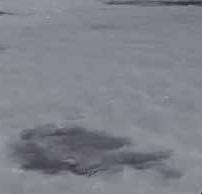



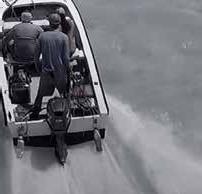

B O N E F I S H J O U R N A L SPRING 2020 W W W. B T T. O R G +1.617.459.4200 | globalrescue.com/bonefishtarpontrust When you travel, When it does, anything can happen. you need us. Medical Evacuation | Security Extraction | Travel Insurance Memberships start at $119 Travel Insurance starts at $20




American hunters and anglers can help stop it. some places are too special. T H E B R I S T O L B A Y R E G I O N O F A L A S K A I S T O O S P E C I A L T O B E P U T A T R I S K B Y T H E P R O P O S E D P E B B L E M I N E , Y E T T H E M I N E ' S K E Y P E R M I T I S S L A T E D T O B E I S S U E D I N 2 0 2 0 . D o y o u r p a r t : S a v e B r i s t o l B a y . o r g / T e l l P r e s i d e n t T r u m p Fly Out Media AlaskaFlyOut com



Through the Guides: Conservation Captain Q & A


Captain Will Benson
Key West, Florida
How has the Keys’ flat fishery changed since you were a kid?
The sheer volume of boat traffic increase is probably the biggest single change I’ve witnessed. Of course there used to be more permit, tarpon, and bonefish, as well as healthier habitat with a live reef off the Gulf edge, so the fishery was much more wild and healthy back then.
What do you see as the greatest threats to the resource?
It’s hard to say what the single biggest challenge we face is, but excluding large scale issues such as climate change and rampant commercial harvest throughout the Caribbean basin, I believe habitat loss, population increase, and predation threats from sharks are the most alarming. Sharks knowing where we fish for tarpon is an issue I didn’t have to deal with when I first started guiding like I do now. Certain places I fish, we no longer attempt to land the fish, only jump them, because of the bull sharks in that area.
What research projects have you helped BTT with?
I’ve helped BTT with a number of research projects, from bonefish genetics to permit tagging, but one particular day of fishing with Dr. Aaron Adams stands out as one of the best days I’ve ever had. At the very end of a windy day, Aaron and I caught and tagged a tarpon over a hundred pounds for BTT’s tarpon Acoustic Tagging Project. That fish swam from Seaplane Basin to the coast of Virginia, proving that our fishery is connected in bigger ways than we knew. I’ll never forget that late afternoon effort and I’ll always be thankful to Aaron for what he and BTT do to help us guides and for not messing up that cast!
Why do you feel it is important for flats anglers and guides to play an active role in conservation?
It’s important for fishing guides to adopt the conservation mentality not only because it makes logical sense for our business but also because it instills an ethos of professionalism and dedication that gets our clients to buy in and come back year after year to share the love for our fishery. Also, the more you pay attention to what’s going on with the fish and the factors that affect them, the better angler you will become.
What are the three most common mistakes that anglers fly-fishing for permit make?
• Not believing that you can catch them.
• Letting go of your fly line.
• Worrying about your cell phone instead of paying attention! Permit fishing requires total focus. Leave the cell phone in the hatch.
Where do you guide?
I guide the flats of Ambergris Caye.
Who taught you how to fish the flats?
I had a lot of interest in the flats and started fly-fishing in the early 2000s. My mentor was Omar Arceo, known as “The Doctor of The Flats.”
What research have you helped Dr. Addiel Perez with?
I’ve donated my time and boat to help Dr. Addiel Perez tag bonefish and observe their behavior. I also inform him when I see bonefish starting their spawning behavior. I let him know the date, time and place.
Why does conservation matter to you?
Conservation is important to me because it protects the source of income for me and my family. Without it I wouldn’t be able to do what I love, which is being in the water and fishing. It’s also a security blanket for the new generation of tour guides who are starting out on their journey with the ocean.
What do you think are the biggest threats to the health of Belize’s flats fishery?
The biggest threats to flats are construction on the flats, the destruction of mangroves, the dredging of the seafloor, and the pollution of plastic bottles in the water.
What are your favorite flies for bonefish, tarpon, and permit?
My favorite fly for bonefish is the Christmas Island Special. For permit a favorite of mine is a spawning shrimp. My favorite fly for tarpon is a red and black toad.
What is your most memorable day on the flats?
One of my most memorable fishing days that I always have on my mind was when I was first starting to guide and Omar and I took an angler out for permit. He was a photographer from National Geographic who had come to fish around San Pedro. That day we landed five permit on fly.

36 B O N E F I S H & T A R P O N J O U R N A L SPRING 2020 W W W. B T T. O R G
Photo courtesy of Capt. Hilian Martinez
Captain Hilian Martinez
San Pedro, Belize
Photo courtesy of Capt. Will Benson

Two Nations, One Fishery
Collaborative research efforts continue between BTT and University of
Havana
BY CHRIS SANTELLA

Political regimes change…and sometimes they don’t. Either way, it doesn’t mean a thing to fish.
“Nature does not understand politics,” ventured Dr. Jorge Alberto Angulo-Valdes, a scientist who splits his time between the Center for Marine Research, University of Havana and Eckerd College in St. Petersburg. “Nature works the way it works, and it’s up to us to understand it.”
One natural process scientists have come to understand: Many fish species, including bonefish, tarpon and permit, make the connection between the shores of Cuba and the coasts of the Florida Keys and mainland at some point in their lifecycles. Indeed, mathematical models suggest that many bonefish larvae in the Florida Keys are coming from Cuba and Mexico, and genetics results suggest the same is true for tarpon and permit. This is one of several good reasons for American and Cuban scientists to work together. Bonefish & Tarpon Trust has been fostering such collaboration since 2016.
Dr. Angulo-Valdes, who has been with the University of Havana since 2001, shared how he first connected with BTT. “My work has always been involved with mangrove and coral reef ecosystems. In 2015, I began studying the impacts of sport fishing in Cuba. [Sport fishing, it should be noted, has a very different connotation in Cuba than it does

in the United States. It refers to fishermen who are using hook and line, but are fishing for subsistence and commercial sale.] We realized that in addition to species like grouper, mullet and snapper, sport fishermen were taking bonefish, tarpon and permit. To measure the impact on flats species, we decided to develop a program. I came to Florida around this time, and met Dr. Aaron Adams, BTT’s Director of Science and Conservation. He was interested in our research, and introduced me to the kind of projects BTT was doing. We both agreed it was a good chance to collaborate and conduct some joint research.”
From a conservation perspective, Cuba presents quite a different picture than Florida. “Most of the places where flats fishing occurs are in Marine Protected Areas (MPAs),” explained Dr. Adams, who is also a Senior Scientist at Harbor Branch Oceanographic Institute of Florida Atlantic University. “Catch and keep fishing is not allowed in these areas, though lobster harvest is permitted. There are no pollution issues in the MPAs, and overall, the habitats are in good shape.”
“Relative to Florida, the coastal habitat in much of Cuba is wellprotected,” Dr. Angulo-Valdes added. “Human intervention has been minimal, largely because Cubans haven’t had the money to develop the coastline. But the commercial and sport fishing have certainly caused damage. Though the fishery law is broad, enforcement is lackadaisical. Different fishermen are allowed different types/sizes of

boats, which determines how much they can fish and where they can fish. They have to provide a certain poundage of fish per month to the government co-op. Anything beyond that allotment—especially the higher quality fish—is sold on the black market.”
“We’ve found that in protected areas where Avalon operates fly-fishing or diving operations, illegal fishing is limited,” added Dr. Fabian Pina Amargos, a professor of protected areas at the Center for Marine Research of the University of Havana and an environmental consultant with Avalon Diving operations in Cuba. “The presence of the skiffs on the water deters the poachers.”
To date, Dr. Angulo-Valdes and his cohorts have focused their surveying efforts on non-protected areas near MPAs in an effort to determine how sport fishery activities are impacting species in protected areas. They’ve interviewed more than 100 fishermen thus far, gathering socio-economic information about the fishermen, reviewing the occurrence of tarpon, bonefish and permit in their harvest and fostering trust that will lead to positive relationships. “We’ve been building environmental awareness with the sport fishermen,” Dr. Angulo-Valdes added. “We believe that if we can convince them to not take certain species, the fish populations will bounce back, as the habitat is intact.”
BTT and the Cuban researchers working with Drs. Angulo-Valdes and

“BTT has been one of the best American organizations I’ve worked with,” Dr. Angulo-Valdes continued. “Working in Cuba can be sensitive, but they’ve been smart and patient. They have their feet on the ground.”
Las Salinas, Cuba. Photo: Richard Kern

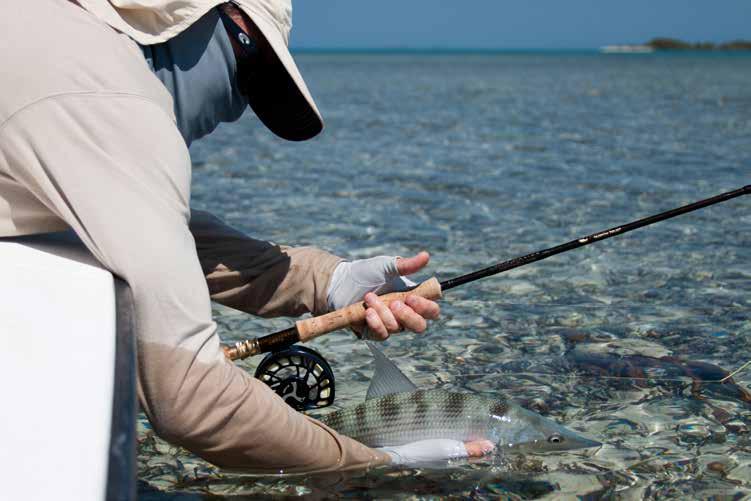
Amargos are collaborating on several other projects in addition to the sport fishery evaluation. One concerns the impact of commercial fishing on bonefish when the fish aggregate before spawning. Interviews conducted around Boca de Manati-Turiguano, on the north central coast, suggest that fishermen using gill nets harvest up to 20 tons of bonefish each season. Tarpon gathering before spawning are also targeted by commercial fishermen, though accurate figures for the scope of harvest are not available.
In order to collect more comprehensive data to assess the commercial take of bonefish, four pre-spawning aggregation sites have been identified, and data collection is ongoing. “The fishermen we have interviewed thus far recognize that overfishing can impact their fisheries,” Dr. Angulo-Valdes said. “They seem eager to collaborate in conservation efforts.” It’s also worth noting that sport and commercial fishermen expressed interest in the potential for adopting a recreational fishery—so long as it can provide a living. A study to place a dollar value on the recreational fishery—that is, the value of a living tarpon, bonefish or permit that could be caught and released vis a vis a fish that is netted and consumed or sold—is currently being conducted by Tamara Figueredo Martin.
The sport fishing analysis and bonefish aggregation harvest studies unfold alongside several ongoing projects: tagging efforts of flats species to chart fish movements in and out of MPAs to determine if adequate range has been protected; tissue sampling to determine the extent that the fish populations in different parts of the Caribbean, Gulf of Mexico, and Atlantic are connected; and tagging of juvenile and midsize tarpon to determine migration patterns, and how connected these populations are to populations in Florida.
 Dr. Aaron Adams releases a bonefish on the flats of Cayo Largo. Photo: BTT
Guide Lazaro Viñola Valdés releases a tarpon at Rio Hatiguanico.
Photo: Dr. Aaron Adams
Dr. Aaron Adams releases a bonefish on the flats of Cayo Largo. Photo: BTT
Guide Lazaro Viñola Valdés releases a tarpon at Rio Hatiguanico.
Photo: Dr. Aaron Adams
New facets of the Cuba-BTT collaboration are continuing to take shape. Working with Eckerd College, Dr. Angulo-Valdes is assembling a program to take students south to participate in research projects. “Our goal is to maximize cultural exchange,” he said.
“Our affiliation with BTT has enabled us to increase our research efforts,” Dr. Amargos added. “We’ve also been able to present our findings at symposiums, exposing more scientists to our work.”
“BTT has been one of the best American organizations I’ve worked with,” Dr. Angulo-Valdes continued. “Working in Cuba can be sensitive, but they’ve been smart and patient. They have their feet on the ground.”
“Our focus in working with international partners is to never tell people what to do,” Dr. Adams from BTT said. “We work to give

support and guidance to help our partners gather information and do what’s needed.”
If Dr. Angulo-Valdes could snap his fingers and make things happen to improve our shared fisheries, here’s what he’d do. “In Cuba, I’d want to see more control on fisheries management, better control on fishing gear. In Florida, I’d love to see people be more nature-oriented, to modify consumption habits that create so much waste. Many people simply don’t realize how their behavior impacts the natural world. Lastly, I’d love see even more collaboration between Cuban and American scientists. If we can better pool resources and share information, we’ll have better outcomes.”
Chris Santella is the author of 21 books, including the popular “Fifty Places” series from Abrams. He’s a regular contributor to The New York Times, The Washington Post, American Angler and Trout
 A permit caught and released in San Lazaro, Cuba. Photo: Dr. Aaron Adams
A permit caught and released in San Lazaro, Cuba. Photo: Dr. Aaron Adams
2020 Artist of the Year
John Kobald
Bonefish & Tarpon Trust is pleased to recognize John Kobald as the 2020 Artist of the Year. Through bronze and wood sculptures, Kobald captures his discerning observations of wildlife and the environment.
“I met John about 15 years ago when he was a fishing guide and an exceptional carver of fish,” said Bill Legg, who serves on the BTT Board of Directors. “Not only did we catch lots of trout, but I am the proud owner of several of his works. John moved on to metal sculptures not long after we fished together and he has crafted beautiful likenesses of not only fresh and saltwater fish, but also of birds. John has been a great friend of BTT and I am thrilled that he is our Artist of the Year.”
Born in St. Charles, Illinois, in 1967, Kobald was taught by his parents at an early age to observe nature and translate it into an art form. He began creating under the guidance of his father Ray, a widely respected artist. Kobald received a bachelor of fine arts degree in sculpture from Northern Illinois University and went on to guide professionally in northwest Colorado.
“My experience as a fly-fishing and hunting guide gives me a unique relationship with the natural world and the people who share this passion,” said Kobald.
Kobald’s fascination with the dramatic presence of wildlife greatly influences his artwork. His travels throughout North and Central America and New Zealand have provided many research opportunities. Watercolor paintings express the varied environments of his travels, including the rivers of the Rocky Mountains, the colorful aquatic life of the oceans, and the moods of the changing seasons.
Commissioned artwork by Kobald is appreciated in private and corporate collections throughout the United States, Europe, Africa, and New Zealand. He resides in northwest Colorado with his wife and two children.
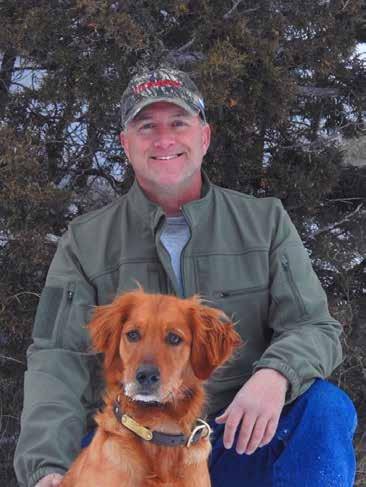
Below: The first edition of John Kobald’s bronze sculpture, “Hitchhikers,” was sold by Copley Fine Art Auctions on February 15, 2020, with all proceeds benefitting Bonefish & Tarpon Trust.

42 B O N E F I S H & T A R P O N J O U R N A L SPRING 2020 W W W. B T T. O R G
BTT Artist of the Year John Kobald. Photo courtesy of John Kobald



Alaska’s Premier World-Class Wilderness Fishing Lodge
Strategically located in the heart of America’s largest state park, Bristol Bay Lodge has the distinct advantage of being utterly surrounded by pristine wilderness. The lodge’s proximity to the watersheds within Wood-TikChik Park and Togiak National Wildlife Refuge means more fishing and less travel time, with flights averaging only 30 minutes. Abundant home water fishing is also minutes from the lodge. We also have day trips and overnight experiences that allow our guests to fish and see Alaska like no other Alaskan lodge. Bristol Bay Lodge has been in business for over 43 years. We would love to have you join us this Summer 2016.

B O N E F I S H & T A R P O N J O U R N A L SPRING 2020 W W W. B T T. O R G 43 BristolBayLodge.com 509-964-2094
BEST PRIVATE BANK—U.S.
–Financial Times Group, 2019
BEST PRIVATE BANK FOR SUCCESSION PLANNING—GLOBAL
–Financial Times Group, 2019
Life’s important decisions deserve the best Our Goals Driven Wealth Management approach empowers our clients to uncover opportunities and make confident decisions that lead to greater outcomes.
ACHIEVE GREATER
To see what we can achieve together, call Alexander Adams, Senior Market Executive, Miami-Dade County at 305-789-1336 or visit northerntrust.com/goalsdriven.

44 B O N E F I S H & T A R P O N J O U R N A L SPRING 2020 W W W. B T T. O R G Member FDIC. © 2019 Northern Trust Corporation. 2019 Global Private Banking Awards presented by Professional Wealth Management and The Banker. INVESTING \ BANKING \ TRUST & ESTATE SERVICES \ WEALTH PLANNING \ FAMILY OF FICE
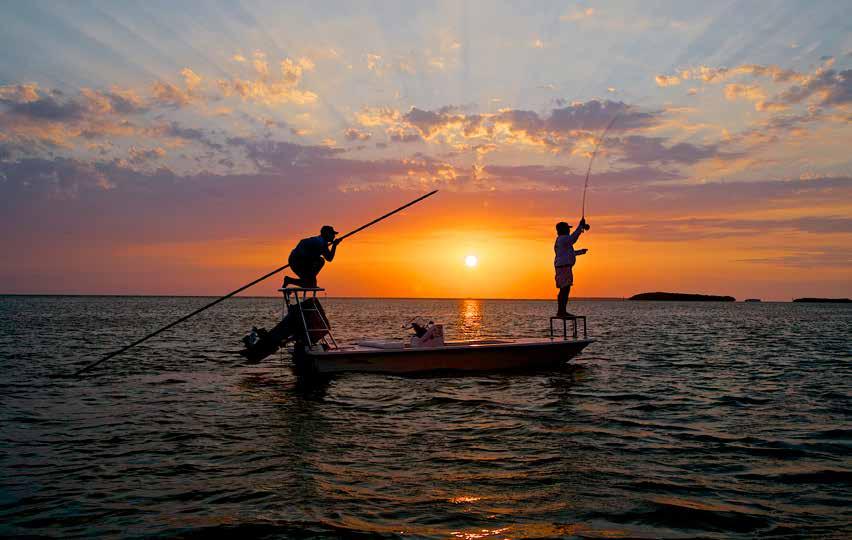

B O N E F I S H & T A R P O N J O U R N A L SPRING 2020 W W W. B T T. O R G 45 Make Clean Water And Healthy Flats A Part Of Your Legacy. Consider making a planned gift to Bonefish & Tarpon Trust to ensure the health of the flats fishery for generations to come. Learn more by visiting:
www.btt.org/donate/legacy
Photo: Pat Ford
BTT Events
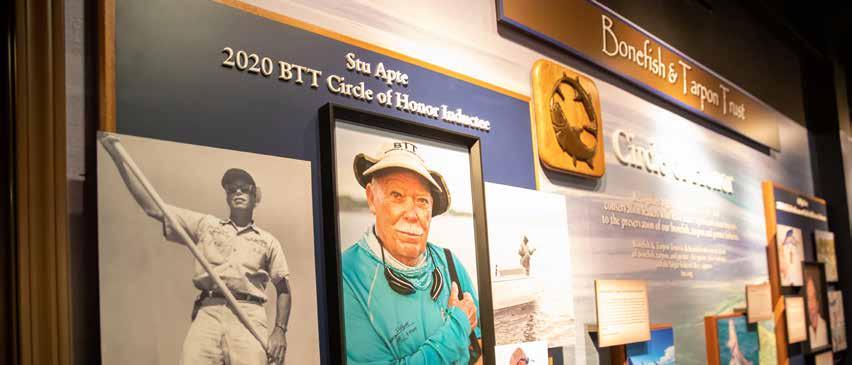
7th Annual Florida Keys Dinner & Awards Ceremony
Angling legends, luminaries and friends gathered on January 16, 2020, to pay tribute to Stu Apte and the late Billy Pate—inaugural inductees into the Bonefish & Tarpon Trust Circle of Honor.
The Circle of Honor recognizes legendary anglers, guides, and conservation leaders who have made significant contributions to the conservation of bonefish, tarpon, and permit. It is housed in the Florida Keys History & Discovery Center in Islamorada, Florida, and features an annually rotating exhibit on those honored along with educational content about the significance of the flats fishery. Past recipients of BTT’s prestigious Lefty Kreh Award, Curt Gowdy Media Award, and Flats Stewardship Award are also enshrined in the Circle of Honor.
A tireless advocate for the conservation of our flats fisheries, Apte is a founding member of BTT and currently serves on the organization’s Board of Directors. After serving as a Navy fighter pilot during the Korean conflict, Apte went on to fly for Pan Am for 34 years, while
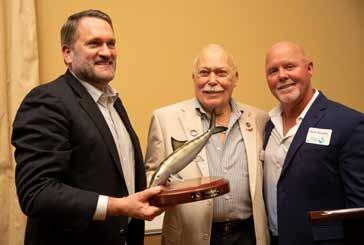
pursuing his passion for fishing. He began fly-fishing in the mid-1940s and, by the mid-1950s, was guiding part-time in the Florida Keys from his home on Little Torch Key. Apte began working as a full-time guide in the 1960s. Over the years, he has held more than 40 saltwater and fly-fishing world records.
Apte was introduced by his longtime friend and fellow legend, Flip Pallot, who entertained the crowd with “stories not suitable for supper.” In his acceptance speech, Apte put this special honor in context.
“These last few years have made me realize, as my time to leave this world is approaching, that I have lived a charmed life,” Apte said. “That the monetary things we leave behind are mostly not important in the basic scheme of things, but that legacy is extremely important. This Bonefish & Tarpon Trust Circle of Honor that is being bestowed on me this evening is certainly the type of legacy that I could ever hope for.”
The late Billy Pate was remembered by Pat Ford, a member of BTT’s Advisory Council and one of Pate’s old friends. He recounted Pate’s passion for the sport as well as his many accomplishments. Best known for one of his long-standing tarpon world records, Pate fished throughout Florida and around the globe. He was the first angler to catch all four species of marlin on fly, and in 1982 caught a 188-pound tarpon on 16-pound tippet, a record that would stand for 21 years. Always an innovator, Pate worked with Ted Juracsik of Tibor Reels to develop a revolutionary line of fly reels that bear his name. And as a founding member of the BTT Board of Directors and Honorary Trustee, Pate was active in the early days of flats conservation. Pate’s wife, Yana, accepted the post-humous honor.
“We are grateful to Stu and Billy,” said BTT President & CEO Jim McDuffie. “Stu has served our organization for more than 20 years, never failing to help us spread our conservation message. And Billy helped shape our organization in the early days. He would no doubt be very pleased to see the progress we’ve made on the tarpon research that he helped inspire. We’re better today because of what Stu and Billy have given to BTT.”
46 B O N E F I S H & T A R P O N J O U R N A L SPRING 2020 W W W. B T T. O R G
The BTT Circle of Honor, housed in the Florida Keys History & Discovery Center, will feature an annually rotating exhibit on those honored as well as educational content about the significance of the flats fishery. Photo: Dan Diez
BTT President and CEO Jim McDuffie presents the Angler/Guide Award to Stu Apte with master of ceremonies Capt. Rick Murphy. Photo: Dan Diez

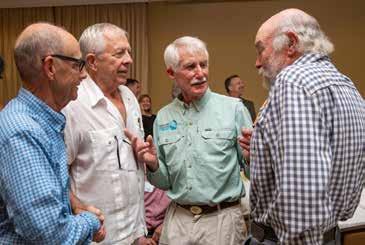
BTT in the “Big Easy” and Atlanta
BTT’s tarpon research and conservation programs in the Gulf of Mexico were in the spotlight on September 26, 2019, when New Orleans members gathered at Audubon Aquarium of the Americas. BTT President and CEO Jim McDuffie, picture below speaking in front of the venue’s 400,000-gallon exhibit, was joined on the program by Dr. Ross Boucek, BTT Florida Keys Initiative Manager.
Atlanta area members enjoyed an afternoon of shooting, great food, live bluegrass music, and a tarpon clinic by angling legend Andy Mill, pictured right, on October 30, 2019. The Burge, a historic, 1,000-acre hunting club was the backdrop for this special event.
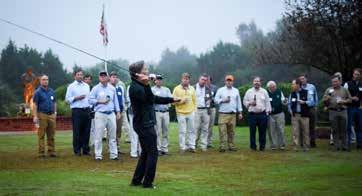

B O N E F I S H & T A R P O N J O U R N A L SPRING 2020 W W W. B T T. O R G 47
Andy Mill shares casting tips with Atlanta event attendees. Photo: Brian Dean
BTT President and CEO Jim McDuffie addresses the audience in front of the stunning Gulf of Mexico Exhibit, a 400,000 gallon simulated saltwater oil rig habitat complete with tarpon, sharks, and rays. Photo: Amy Tidovsky
BTT Advisory Council member Pat Ford and Yana Pate. Photo: Dan Diez
Dr. Lloyd Wruble, Norman Duncan, Capt. Steve Huff, and Flip Pallot. Photo: Dan Diez

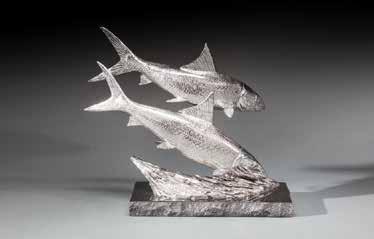

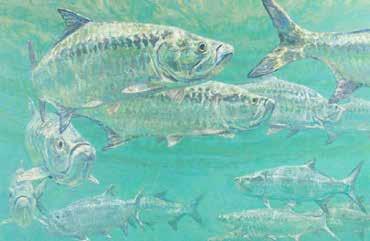
48 B O N E F I S H & T A R P O N J O U R N A L SPRING 2020 W W W. B T T. O R G Accepting quality consignments for THE SPORTING SALE JULY 2020
| SOLD FOR $15,600
Ewoud de Groot, Resting Terns (detail)
| SOLD FOR $12,000 Mike Stidham, Silver King Circle | SOLD FOR $10,200
Kent Ullberg, Silver Ghosts

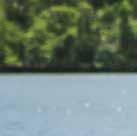

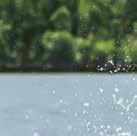

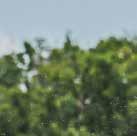


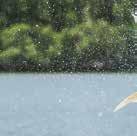
DESIGNED WITH INTENTION
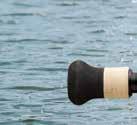

SALT HD / SALTWATER SPECIFIC












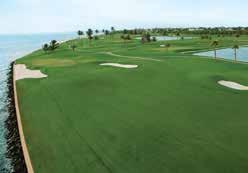


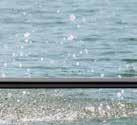






B O N E F I S H & T A R P O N J O U R N A L SPRING 2020 W W W. B T T. O R G 49
$100,000 +
McKenzie Foundation
National Fish and Wildlife Foundation
Ocean Reef Conservation Association
$50,000 - $99,999
Anonymous
Bass Pro Shops
Evan Carruthers
Costa
Davidson Family Foundation Inc.
Friends of Fish Foundation
Christopher Galvin
Robert W. Galvin Foundation
Sweetwater Brewery
Mark Walsh
$25,000 - $49,999
Broadbent Family Foundation
Everglades Foundation
Russ Fisher
Henry E. & Consuelo S. Wenger Foundation
Gerold Klauer
Lower Keys Guides Association
Maverick Boat Group
Carl Navarre
The G. Unger Vetlesen Foundation
The Leigh H. Perkins Foundation
The Nancy Dunlap and John D. Johns Charitable Fund
Paul Tudor-Jones
$10,000 - $24,999
John Abplanalp
Abrams Capital Management, LLC
Rich Andrews
Paul C. Aughtry
Adelaide Skoglund & Bill Legg
Bonefish Grill
Bristol Bay Lodge
Adolphus A. Busch
Chase and Stephanie Coleman Foundation
David Collier
Curtis and Edith Munson Foundation
Far Bank
Frederic C. Hamilton Family Foundation
Glen Raven Inc.
Randall Greene
Josh Gruss
Haas Outdoors, Inc.
Hawks Cay Resort
Herndon Foundation
Hewit Family Foundation
Horizon Foundation, Inc.
Peter R. Kellogg
David Leishman
Marshall and Jamee Field Family Fund
Mick and Kather Aslin Foundation Fund
Mostyn Foundation Inc.
Mr. and Mrs. James E. S. Hynes Foundation Fund
Jon Olch
Peloton
Phil and Mary Beth Canfield Charitable Fund
Alex Powers
Steve Roberts
Silver Kings Holdings Inc.
Simms Fishing Products
Soka Piiwa Foundation
Alan Steele
Stephanie and Lawrence Flinn, Jr. Charitable Trust
The Farmer Family Foundation
The Harold and Ramona Brewer Charitable Fund
The Kim and Sue Ratliff Family Fund
The Moore Foundation Inc.
The Thomas and Elizabeth Grainger Charitable Fund
Tim & Karen Hixon Foundation
W. August Hillenbrand Family Foundation
David Wahl
$2,500 - $9,999
Adams Legacy Foundation
American Fly Fishing Trade Association
Andes Drifters
Linville Family Foundation
Lew Armistead
Kelley Armour
Carter Bagley
Bahl Family Foundation
Bar Fly Saltwater Grill
Baterbys
Bob Beamish
Ronald N. Beck
Belize River Lodge
Dan Berger
Bessemer Trust
Blue Sky Family Foundation
Ivar Bolander
Connor Bost
Charles Brennan
Tom Brokaw
John Brownlie
Buck Family Fund of the Maine Community Foundation
Bullard Foundation
Rob Bushman
James Cafferty
Keith Calhoun
Charles Causey
Cheeca Lodge & Spa
Paul Collins
Community Foundation For a Greater Richmond
Community Foundation of the Chattahoochee Valley
Copley Fine Art Auctions
Patrick Coughlin
Orin Council
Cove Point Foundation
Coxe Fund
Crossroads Mill Foundation
Brady B. Crouch
Joseph H. Davenport
Dianne and Daniel Vapnek Family Fund
Joseph Dimenna
Stephen Donson
Peter Dowling
Dreamcatcher Foundation, Inc.
East End Lodge
Ed Uihlein Family Foundation
El Pescador Lodge
Ronald Elenbaas
Elm Grove Foundation
Eric W. Roberts Fund
Fay Ranches
David Fleig
Robert Ford
David Galvin
Gerry Charitable Fund
Global Rescue
Andrew Gnazzo
Victor Grijalva
Frederic Hamilton
Henry Harrell
Harrison and Nancy Buck Fund of the Princeton Area
Community
John Hawkins
Rick Hendrick
Herndon Giving Fund
William Hespe
Robert Hewett
David Higley
Richard L. Hirsch
Hamilton E. James
Jeff S. and Jodi L. Harkavy Family Foundation
Jim and Jonnie Swann Corporation
John Oster Family Foundation
Christopher Jordan
Jane Jozoff
Jeffrey Keenan
Gregory G. Kelley
Mercedes Kelso
Kidder SBSM Fund
Michael King
King Tree Service
Nancy Kling
James Konkel
Bob Kopras
Charles D. Koteen
Rick Lang
Jim Lang
Michael LeBourgeois
Robert Lee
Robert Lindsay
DeeDee Lisenby
Dorothea and Terry Lisenby
Lovett-Woodsum Foundation, Inc
James Lyon
Robert Maricich
Jonathan Markey
Maverick Capital Charities
Mark McGarrah
Kayla McGuire
Wayne Meland
Merrill Lynch, Pierce, Fenner, & Smith Inc
Nicholas Miller
Mitchell Family Fund
Greg Moffitt
Moorhead Family Fund
Ranney Moran
H. B. Morley
Natori Company
John L. Nau
Nautilus Reels
Nelson & Janie Sims Family Fund
John Newman
David E. Nichols
Therese Nickels
Northern Trust
William J. Nutt
Orvis
Patterson Family Group
David Perkins
John Perrin
Charles Porter
R.K. Mellon Family Foundation
Ransom Everglades School
Richard W. And Theresa R. Barch Foundation
Alexander Robertson
Mark K J Robinson
Kris Rockwell
Rough-J-Ranch Foundation
S. Kent Rockwell Foundation
John W. Salisbury
Jeffrey H. Salzman
Savannah Sport Fishing Club, Inc.
Bert Scherb
Goldman Sachs Gives
Jeannie Schiavone
Seattle Foundation
Leigh Seippel
Cecil Sewell
Ted Sheely
Paul Skydell
Ann and Hamilton Sloan
Todd Smith
Mark Spurgeon
50 B O N E F I S H & T A R P O N J O U R N A L SPRING 2020 W W W. B T T. O R G
2019 Donor Roll
Josh Stapp
Edwin R. Stroh
The Baltoro Trust (Yvon Chouinard Family Trustees)
The Bishop Family Foundation
The Burton Foundation
The Christine & Rodman Patton Charitable Fund
The Gilbert Verney Foundation
The Islander Resort
The Perkins Charitable Foundation
The Rosenthal Family Foundation
The Stephen and Ann Reynolds Fund
The Thoroughfare Fund
The Warwick Foundation
The Weld Foundation
The Winston-Salem Foundation
Thomas D. Terry and Sue A. Conatser Giving Fund
Joseph Tompkins
Steve Trippe
Andrew Tucker
John L. Turner
Robert Turner
William Underwood
Vineyard Vines
Joanthan Wang
Washington Fly Fishing Club
Waypoint Communications LLC
Art Webb
L. Mark Weeks
William W. Rowley Donor Advised Fund at the Cleveland Foundation
Gene E. Wilson
Rick Witmer
Ocean Reef Community Foundation
Alex Woodruff
Lloyd Wruble
Stephen Zoukis
$1,500 - $2,499
Cody E. Abbott
Eduardo Arceo
Boca Grande Charities, Inc.
Denton Browning
Scott N. Christian
David and Avery Keller Family Fund
Joe Dorn
Tom Hollinshed
Doug Hudson
John Killian
Karl Koenig
Jonathan Kukk
Bruce Langereis
Michael Ledwith
Lee W. Mather
Alexander Mehran
john Moritz
Ryan E. Morris
Network for Good
Wayne Nordberg
Orlando Outfitters
Polk Brothers Foundation
Fred Rehbein
Richard L Hirsch Charitable Fund
Jake & Laura L. Savage
Edgar Diaz
T.C. Snyder Fidelity Charitable Gift Fund
The Darrel and Dee Rolph Family Fund
The Theo B. Bean Foundation, Inc.
$1,000 - $1,499
Christian Andrea
Joan Angelloz
Drew Bagot
James Bankston
Andrew Barbour
Peter Bartley
Jeff Beacom
Crosby Beane
Carl Behnke
John Thomas Behrendt
Christopher Bensen
Ryan Benson
Ben Bergeron
Bessemer Trust
Ajaib Bhadare
Blue Bonefish Belize
Brett Bossung
Curtis Bostick
Harrison Buck
Alexander Buck
Norman H. Buck
Christopher Buckley
Thomas Buhr
Robert Byrd
Marty Cannon
Casey Family Fund of The Oregon Community Foundation
Charles Causey
John Charpentier
Bob Chilton
Christopher and Susan Barrow Family Fund
CD Clarke
John Cleghorn
Robert Cline
Robert M. Cobb
Philip Coon
Malcolm Cowen
Chip Crowther
Anthony P. Davino
Joe Dickerson
Paul DiMaura
Charles Duncan
James Ellsworth
Davis Fansler
Adam Feber
Kyle Fink
Richard Finlon
Paul Fitzgerald
Harlan Franklin
Matthew Fritter
Richard Fulton
Allen Gant
Patrick Gerschel
Peter Goldman
Stuart M. Goode
James H. Greene
William Happy
Greg Hartmann
Hell’s Bay Boatworks
David Higley
Richard Hillenbrand
Bill A. Hillenbrand
Dwight Hilson
Brad Hines
Charles Hinnant
Bill Horn
Brian Hoskins
Patrick Hylant
Jim and Chris Scott Family Donor Advised Fund
John and Susanne Hoder Charitable Fund
Michael Johnson
Melissa Keiswetter
Larry Kennedy
James Kennedy
Lawrence Kennedy, Jr.
Aaron Kennon
Rip Kirby
Richard R. Kracum
Kurt Kreider
Bob Kuppenheimer
Huey Lewis
Richard Loebs
Paul Lubbers
John Maddox
Mark Mahaffey
Max Makowsky
Marlee and Rick Snowdon Charitable Fund
Scott McDougall
John McDougall
Bank of America Charitable Gift Fund
Stephen McLaughlin
Ford McTee
Robert Merrick
Michael W. Haley Foundation, Inc.
Judson Moore
Gray Murray
John Nagy
Bill Nevins
Skip and Cyd Nielsen
Copley Fine Art Auctions
Steve O’Brien
Clint Packo
Bryan Pearman
Peil Charitable Trust
David Pollack
Robert Power
Susan Powers
Nick Ragland
Paul Raulet
Greg Ressa
Roberts Family Foundation
Steven Rowe
William Royall
Bennett Sapp
Chris Sawch
Peter G. Schiff
Scott Schlesinger
John F. Schneider
Fred Schulte
Rudy Schupp
Fred Schwaibold
Bill Seals
Steve Sellers
Robert A. Sewell
William S. Sheley
John W. Shultz
Marvin Siegel
Scott Sims
David Slick, Sr.
James Smith
Blackwell Smith
Charles Smithgall
Carlos Solis
Bailey Sory
Craig Souser
Carl Sparks
Steve Stanley
Richard Stebbins
Craig L. Stemmer
Stewart Family Fund
Susman and Asher Foundation
Scott Tenney
Jonathan Thaw
The Dan & Merrie Boone Foundation
The Frederick P. Bartlett Charitable Fund
The Shana Alexander Charitable Foundation
Michael Theobald
Stephen Tomlinson
Joe Traba
Don Turcke
Erik Tuveson
Michael Waite
Susan Watson
Theodore S. Weymouth
Melody Wilson
Will Wingate
Jim Worden
Joan Wulff
B O N E F I S H & T A R P O N J O U R N A L SPRING 2020 W W W. B T T. O R G 51
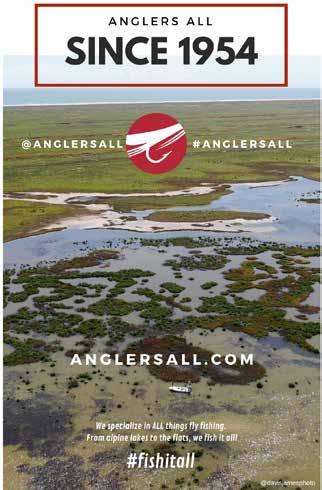
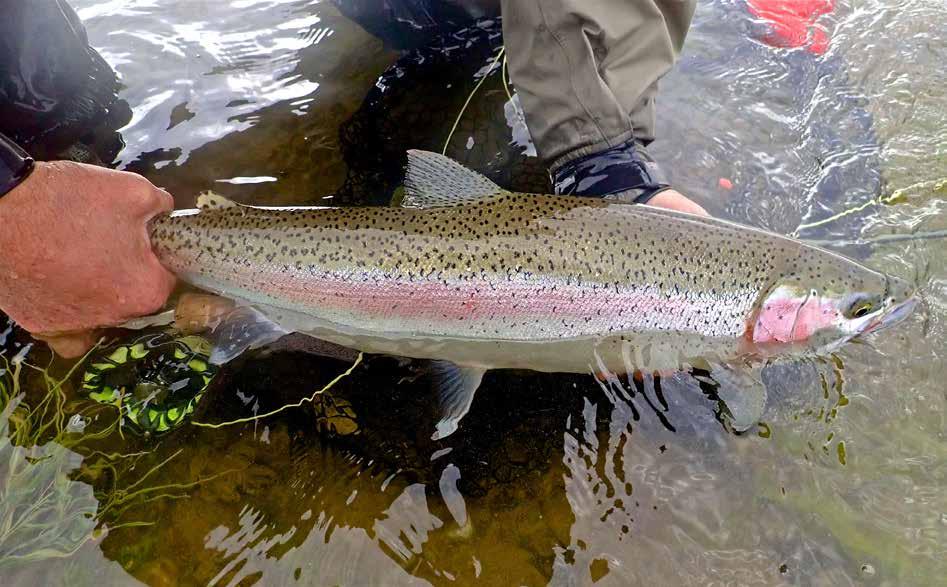


J O U R N A L SPRING 2020 W W W. B T T. O R G Give the "Bones" a break, come up to the cool refreshing waters of wild Alaska and chase "Bows" 800-458-6539 | rainbowking.com 1-800-245-1950 | www.frontierstravel.com Sporting Travel Since 1969 Big hole lodge Exclusively represented by Frontiers, Craig and Wade Fellin’s Big Hole Lodge is clearly defined as one of the great fly fishing destinations in North America. Call us today to plan your dream itinerary. COME SIP WHATS IN SEA-SON BONEFISHGRILL.COM






B O N E F I S H & T A R P O N J O U R N A L SPRING 2020 W W W. B T T. O R G 53 FLY FISHING OVER 200 SQUARE MILES OF PRIME BONEFISH HABITAT DELPHI-BAHAMAS.COM IT FISH WELL YOU G E T ONE LIFE And while you’re at it, Protect it Well. Global flats fisheries rely on healthy habitats, and through research, stewardship and advocacy, their bonefish, tarpon and permit have a fighting chance. With BTT bringing science to the battle, the future looks bright. CLIENT: DATE ELEMENT NAME: NOTES: APPROVED BY: MAKE: 207-632-5214 REVIEW: SIMMS CONTACTS: RICH HOEHN_406-599-1308 SIMMS 6 / 18 / 19 BTT_SIMMS FIW AD 3.625X4.875 SIMMS ORANGE IS PMS: 1675c REV SIMMSFISHING.COM Africa • Alaska • Argentina • Bahamas • Belize • Bolivia • Brazil • Canada • Chile • Cuba • Christmas Island Cook Islands • Costa Rica • Guatemala Dubai • Guyana • Iceland • India • Kamchatka • Mongolia New Zealand • Seychelles • St. Brandon’s • Tanzania • Yucatan • United States & More! FLY FISH THE W ORLDADVENTURES WWW.YELLOWDOGFLYFISHING.COM • Toll free: 888.777.5060 YELLOW DOG IS PROUD TO SUPPORT BTT AND THEIR EFFORTS TO PRESERVE AND RESTORE FISHERIES AND HABITAT. AND WHEN IT COMES TO TRAVEL LOGISTICS AND PLANNING FOR THE WORLD’S BEST DESTINATIONS, YOU KNOW THAT YOU’RE IN GOOD HANDS WITH YELLOW DOG. BECAUSE FLY FISHING TRAVEL IS WHAT WE DO.
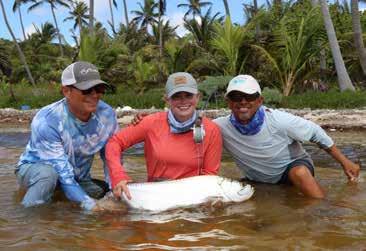


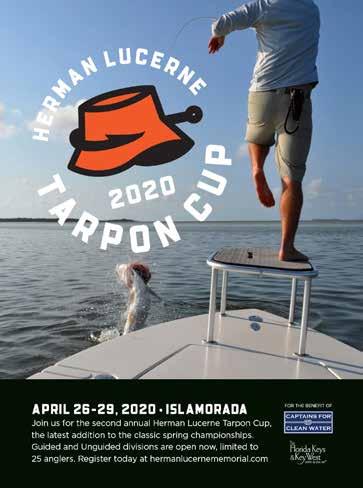
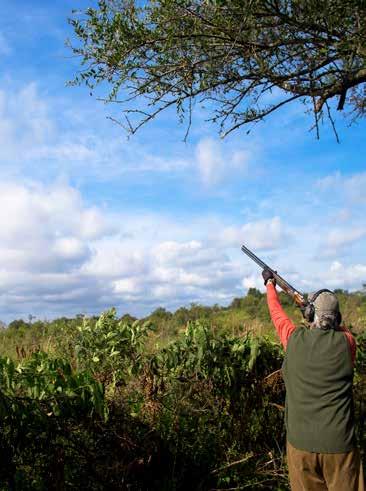

54 B O N E F I S H & T A R P O N J O U R N A L SPRING 2020 W W W. B T T. O R G 1-800-245-1950 | www.frontierstravel.com Sporting Travel Since 1969 david denies
Extraordinary terrain and expertise are instrumental in this exceptionalvolume dove shooting experience. Horacio Dartiguelongue and his tenured field staff provide this each day; guests on their 20th visit still marvel. Call us today to plan your dream itinerary. pica zuro, la dormida, and cordoba lodges The Best Fishing. The Best Guides. The Best Memories. The Best of Belize. 804-661-2259 • www.elpescador.com • info@elpescador.com
bird hunting

Salvelinus

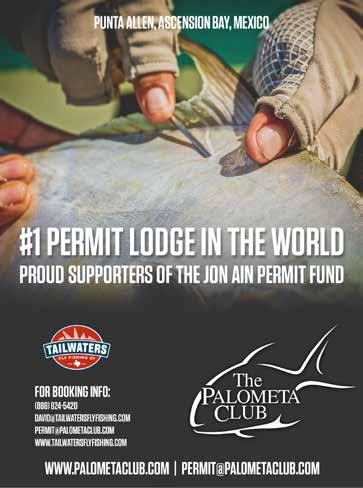



Experience the unspoiled nature of Spain’s Pyrenees where crystal clear waters teem with wild trout. You’ll have access to more than 60 rivers and 180 lakes all within easy driving distance of the 2 lodges Salvelinus utilizes, both of which feature comfortable accommodations, delicious Mediterranean cuisine and Spain’s
Call us today to plan your dream itinerary.



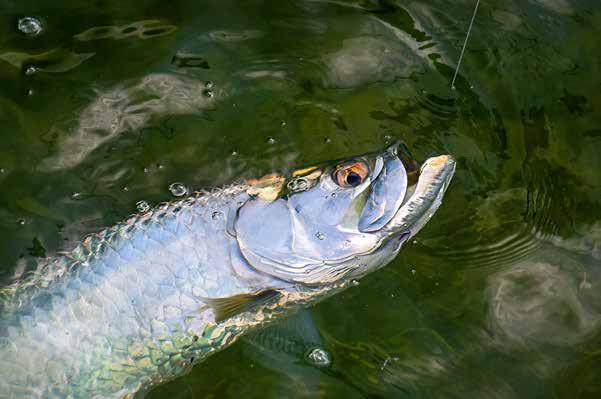

B O N E F I S H & T A R P O N J O U R N A L SPRING 2020 W W W. B T T. O R G 55 1-800-245-1950 | www.frontierstravel.com Sporting Travel Since 1969

56 B O N E F I S H & T A R P O N J O U R N A L SPRING 2020 W W W. B T T. O R G

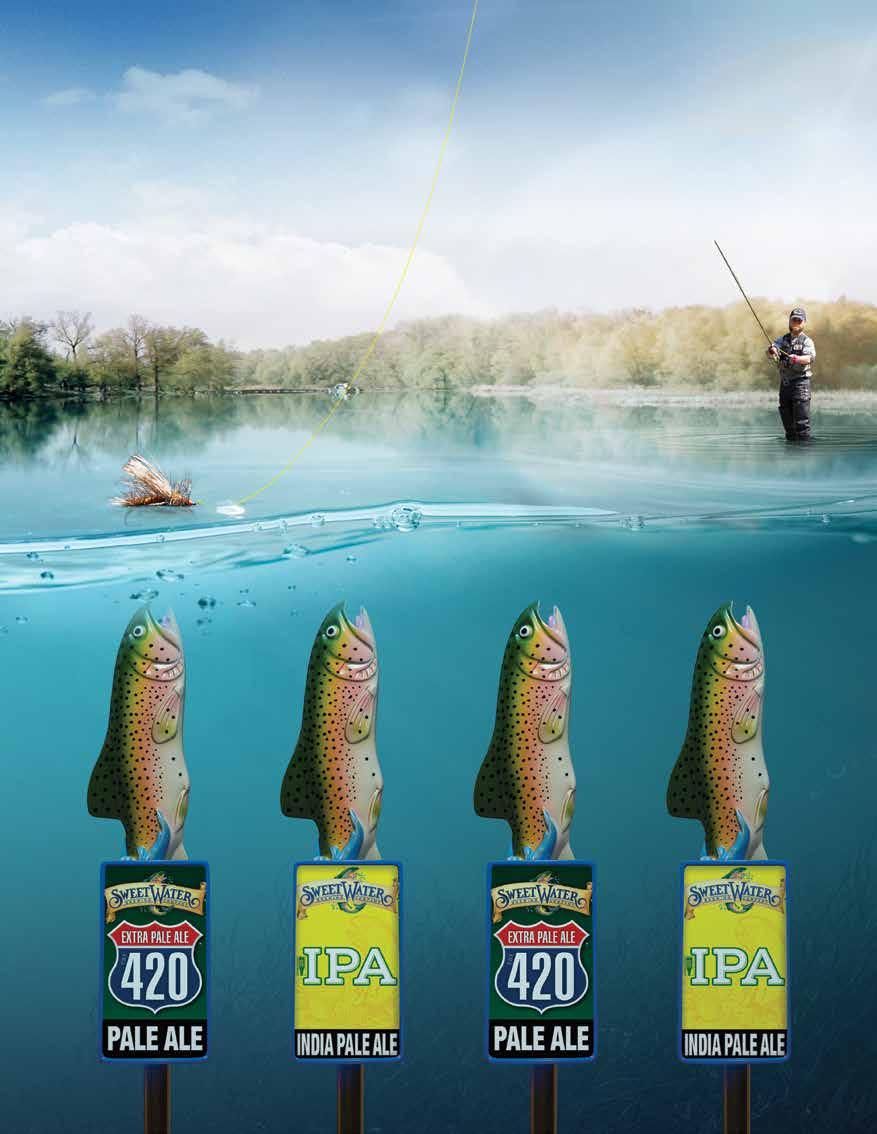
SweetWater Brewing Company • Georgia • SweetWaterBrew.com • Please Enjoy Responsibly









 Harold Brewer, Chairman Jim McDuffie, President
Harold Brewer, Chairman Jim McDuffie, President



 Key West, Florida. Photo: Ian Wilson
The 2017 BTT International Science Symposium’s Tarpon Legends Panel (left to right): BTT founding member Stu Apte, BTT board member Capt. Paul Dixon, Capt. Tommy Locke, Capt. Paul Tejera, BTT Vice Chairman Bill Horn, BTT board member Julian Robertson III, Capt. Bouncer Smith, Andy Mill, and BTT collaborating scientist Lucas Griffin. Photo: Pat Ford
Key West, Florida. Photo: Ian Wilson
The 2017 BTT International Science Symposium’s Tarpon Legends Panel (left to right): BTT founding member Stu Apte, BTT board member Capt. Paul Dixon, Capt. Tommy Locke, Capt. Paul Tejera, BTT Vice Chairman Bill Horn, BTT board member Julian Robertson III, Capt. Bouncer Smith, Andy Mill, and BTT collaborating scientist Lucas Griffin. Photo: Pat Ford


 BTT Education Coordinator Maggie Winchester. Photo courtesy of Maggie Winchester
New BTT board member John Johns. Photo courtesy of John Johns
BTT Education Coordinator Maggie Winchester. Photo courtesy of Maggie Winchester
New BTT board member John Johns. Photo courtesy of John Johns


 BTT
Dr. Addiel Perez conducting research in Xcalak, Mexico. Photo: Patrick Williams
South of Ambergris Caye, Belize. Photo: Scott Morrison
BTT
Dr. Addiel Perez conducting research in Xcalak, Mexico. Photo: Patrick Williams
South of Ambergris Caye, Belize. Photo: Scott Morrison





































































 Dr. Aaron Adams releases a bonefish on the flats of Cayo Largo. Photo: BTT
Guide Lazaro Viñola Valdés releases a tarpon at Rio Hatiguanico.
Photo: Dr. Aaron Adams
Dr. Aaron Adams releases a bonefish on the flats of Cayo Largo. Photo: BTT
Guide Lazaro Viñola Valdés releases a tarpon at Rio Hatiguanico.
Photo: Dr. Aaron Adams
 A permit caught and released in San Lazaro, Cuba. Photo: Dr. Aaron Adams
A permit caught and released in San Lazaro, Cuba. Photo: Dr. Aaron Adams



















































































